The railways of Penzance and beyond in the steam and diesel hydraulic eras
Recently acquired images appear temporarily below as a visual indication of recent website changes – the newest added at the top. They also appear, or will soon appear, definitively on appropriate pages. Please use the ‘Search Box’ above to find what you are looking for across the whole of the website.

The “gem” of my collection so far, I think, as a double headed express pulls away from Penzance Station in the early 1900s with steam and smoke spreading everywhere. The original signal box – rarely seen in remaining photographs – is nearly opposite single line token equipment, and a brave man ascends a precarious ladder to the cable runs on the wall. 10####A02-PNZ-S_LCO-PAS_U

7921 “EDSTONE HALL” drifts into Gwinear Road Station with a Penzance-bound passenger service of mixed stock. In the foreground is track maintenance equipment and behind is a rake of cattle vans, by this time used for “broccoli’ grown prolifically locally. To the right beside the loading gauge is a gas wagon, providing fuel for remote locations “off the grid”. 60###AN01-SAU–D825-PAS_U

Bright sunshine casts shadows on the platform that a freight train is drawing away from as D825 “INTREPID” waits opposite for a restart at St Austell Station in the early 1960s, The locomotive has yet to receive its yellow warning panel – that I personally think detracted from its appearance – and heads maroon coaches. The ‘parachute’ water tower still remains behind. 5####CZ01-GWI-S_LCO-PAS_D

A local train, possibly from Chacewater judging by its arrival platform, arrives at Truro from the west, as a 2-6-0 named loco waits near Truro West Box. The signals have yet to all be replaced with BR standard versions, though a concrete lamp standard shows more clearly modernisation is in progress. Behind lies Truro depot, with its new DMU facility. 5####DA01-TRU-s45XX-PAS_U

Well-run-in HST set 253007 is at Penzance, Platform 1, awaiting departure on a grey afternoon, where only its yellow front brightens the scene. The granite wall sprouts buddleia that is reflected in the grime on the locomotive’s front end – the raised curved panel behind the cab roof was an experiment to try to minimise exhaust stains from obscuring the windscreen. 8####BW01-PNZ-2~007-PAS_U

Both cab windows of 50038 “Formidable” are occupied by staff as the engine pulls away west from Hayle over the viaduct in the Summer of 1978. In the background are the “Towens” – the huge sand hills between the town and the sea – and the chimneys of the former coal-fired power station. A refuge for track workers can be seen above the right hand pillar. 780713A01-HYL-50038-PAS_D

On 24th April 1960 5538 simmers while the crew rest on a station seat beside it at Truro’s bay platform with a three coach train for Falmouth. Shadows are cast by the soft sun, and the beautiful granite wall beside intimates the rising incline of the road behind it with a sloping course of slabs, cutting across the horizontal courses. The rest of the station is deserted. 600424A01-TRU-s5538-PAS_O

Passengers board the branch service to Truro at Falmouth Station on 24th April 1960, with 5538 surrounded by buildings and other facilities soon to be “rationalised” away – only the platform on the left with its curved top awning were to survive. The jibs of dockyard cranes are discernable in the background, as are a plethora of framed signs on the station wall. 600424A02-FAL-s5538-PAS_I

50016 powers through the site of Chacewater Station with a Mk1 Midland service in August 1974. The former up platform beside the loco has been bulldozed into a heap of debris, with vegetation thick upon it, and on the down platform, the station building and signal box, remain, and behind, the Blue Circle cement terminal tower forms a prominent landmark. 7408#AB01-CWR-50016-PAS_U







On the first day of regular service, 252001 arrives at Paddington Station, surrounded by the curious to see or travel on this new, shiny train. It is finished in the Pullman livery, with broad horizontal stripes at cantrail height distinguishing first from standard class and catering cars, and the front and rear ends show the unique positioning of the warning lights. 750505A00-PAD-2~001-PASGR

The high screen of trees mask much of the former station yard at Marlow, now short-sightedly in private hands, and gives the railway little room for future expansion as the utility is “squeezed in” by domestic development. Traditional spearpoint railings flank the other side of the track as DMU set L130 trundles in along the single track access. 77###AD01-MLW–L130-PAS_O

Groups of departing passengers are on the platform as D6306, in battered original livery but small warning panel and unusual surface-mounted headcode boxes, uses the crossover at Bodmin General station to run around the three-coach train it has brought in, The carriages seem somewhat bleached and more akin to engineer’s vehicles than standard stock. 6####IJ01-BOL-D6306-LIGHT

This view from Par station shows 45136 with the 09.21 Leeds to Penzance smoking away as it awaits departure. The view beyond is interesting as it shows the sinuous trackwork and AWS ramps westwards, chapel siding and the chapel to the right, an array of semaphores, houses of the village, and the ECC Par works in the distance – building and chimneys. 850410A01-PAR-45136-PAS_D

A clever, well-composed and sharp picture of a ‘Hall” class steam locomotive – the centre of attention – interrupted by the arrival of 253006 with an inbound service in 1978 (?). The reporting code numbers have been assembled to read ‘125’ – the maximum speed of the HST units – and the two red lights of the stop blocks are reflected on the smokebox door. 78###AA01-PAD-LOCOS-PAS_U
A 4-PEP unit passes through Clapham Junction towards Waterloo in the late Seventies. To me this, visually, is industrial design at its finest externally – though these (Pack ‘Em Perpendicular) units left much to be desired internally: doubtless to accommodate strict commuter volume. Like the HSTs, the front ends of these trains were a breath of fresh air in appearance. 7####HD01-CLJ-4-PEP-PAS_U

Recently painted 0825? Is sandwiched between two other 08s on Landore depot in 1984. It has been reduced in height to work on the Burry Port and Gwendraeth Valley line where there was low clearance under bridges (built on what was formerly a canal system and replacing Class 03s). The nearest loco is 08361, and at the other end of the consist is a Class 37. 84###AC01-LRE-08XXX-PARKD
A familiar scene to me as I’d scan the platforms on my way home from work each day, and sometimes to work if I had the time. 25177 is parked out of the way near the west side of Euston Station among Class 86 electrics. In the background are parcel vans – the end of the incline to the sorting area above is at the right of the image. 86211 has yet to receive marker lights. 8####BV01-EUS-25177-PARKU

The facade of the former LNWR Oxford station of Rewley Road, next door to the ex-GWR that was by now the main city one, is in a state much as when I first saw it, converted to a garage and no doubt a bit of a come-down from its former glory. Between-times it functioned as Oxford’s goods terminal, with the lines north from it just lying derelict until development. 7####HC01-OXF-S_BLG-VIS_N

6991 “ACTON BURNELL HALL” enters St Erth Station from the east with a train of maroon coaches on a cloudless Summer’s day, between a 45XX tank headed St Ives branch train on the left and down refuge sidings on the right. Such sidings were sometimes used to store stock that could not be accommodated in the Penzance area, some 4 miles distant. 6####IM01-STE-s6991-PAS_D

50019 with an acs service behind crosses Hayle Viaduct westwards towards Penzance on 22nd July, 1978. Since I first saw it, the locomotive has gained a metal headcode panel with marker light insets, and has been named, “Ramillies”. The A30 buzzes with cars and the low stone wall between them and the viaduct hides the sight of the first Hayle Station. 780722A01-HYL-50019-PAS_D

Marylebone Station façade in 1980. This was the terminus for services to Aylesbury when I lived there, and DMUs were pretty-well the only traffic on the route. Later for several years I walked close by, backwards and forwards to work, but passed closer to the ex-BRB Headquarters at 222 Marylebone Road, and rarely visited this rather unenticing station behind it. 80###AI02-MYB-S_BLG-VI__N
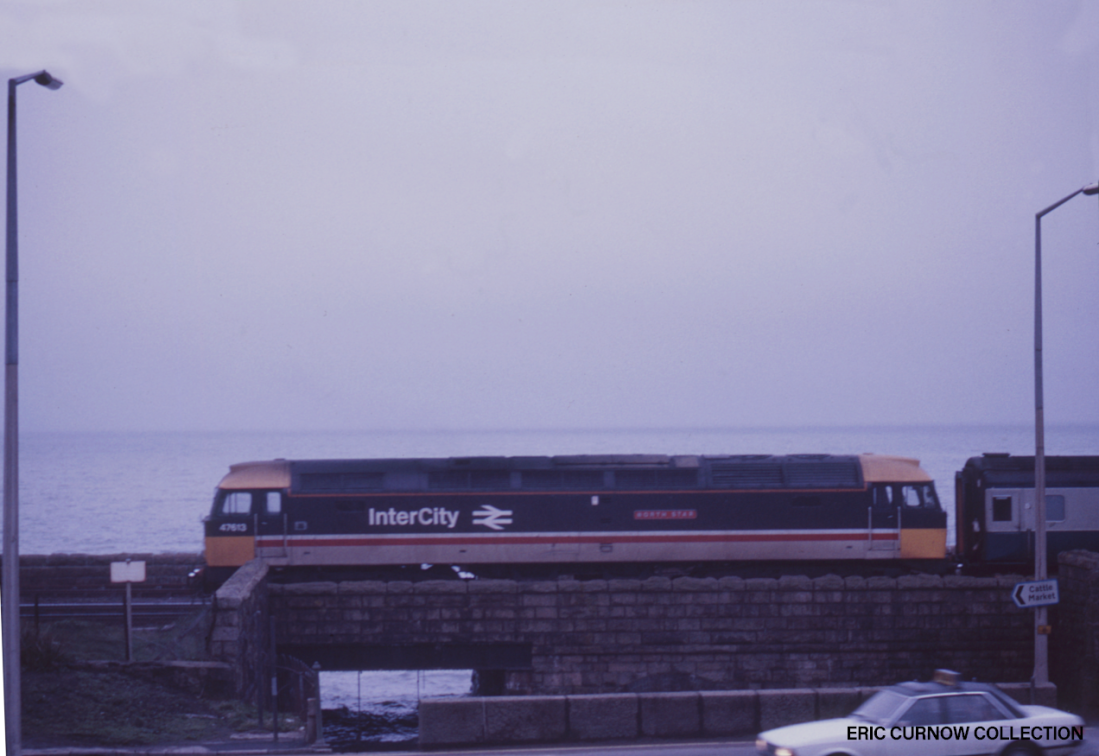
47613 “NORTH STAR” cautiously leaves the pointwork of Penzance Station as it gains the up main with an acs train on 15th April 1988, Below it are the “Three Tunnels” – the left, a metal bridge and the other two, largely hidden, are more conventional arched stonework of an earlier era. This was the earliest access from the town to the beach when I was young. 880415A01-CHY-47613-PAS_U

The damp air of 1st June 1974 has exhaust pumped into it as D1053 “WESTERN PATRIARCH” waits at Penzance Station’s No.1 platform with an up service. Its roofline is caked with encrusted carbon except for a some patches where the internal heat has burnt it off, and the other platforms only host a few distant vans, a Class 47 goods service and a single unit. 740601A01-PNZ-D1053-PAS_U

The driver of D6310 looks back along his train as it rumbles over the creaking points to guide it onto the main line south from Exeter St Davids. The first part of the consist is a tank and GUV, and echoing the loco, their general appearance is shabby. Behind is the open space caused by removal of the former steam depot, and now nere peripheral parking for staff. 7####HB01-EXE-D6310-GDS_D

The second man looks at the cameraman as D6348 and a coupled classmate head an up goods from Plymouth Station past the site of the former Mutley Platform. Both are in original green but with yellow warning panels added, and in very unkempt condition. In the background is ‘Home Park’, where Plymouth Argyle’s ground is just over the horizon. 7####HA01-PLY-D6348-LIG_U

08946 is parked at the north end of the depot at Oxford. Remedial work is going on around the site and materials have still to be cleared. In the background is the wasteland so intriguing to me, as the stunted trees and bushes hid the history of the old steam shed and I just couldn’t comprehend how it could be totally obscured in such a short space of time. 8####BI01-OXF-08946-PARKD

A passenger leans from a window of 3-car Class 120 DMU headed by 51578 as it rolls into Penzance Station in 1979. Behind it a Class 50 and 47 are parked up awaiting movement, and the scene is also dominated by the bright red of the semaphores in the foreground and the granite station wall – its continuity broken by the unusual white memorial in the distance. 79####B01-PNZ-51578-PAS_U

The redundant headcode box of D1033 “WESTERN TROOPER” now displays its number as it is left by its driver, walking towards Penzance station buildings with his lunch box. This is a particularly interesting view to me as I never saw it myself. – although I sometimes ventured onto the platform slope, I never went close to or across the running lines. 7####GZ01-PNZ-D1033-PAS_U

Prototype High Speed Train 252001 is in a very short formation as it passes west through Didcot station in 1974, possibly in one of its UK railway speed record attempts. It’s headcode is an exceptionally-rare three lights, all the more visible because of the dark drizzly day of it’s visitation, and there seem few present on the platforms to witness the unusual sight. 74###AQ01-DID-2~001-TES_T

Sempahores for the up and down main lines signal clearance for passing trains as D1055 “WESTERN ADVOCATE” draws from the west into Liskeard with the 16:10 to Paddington on 7th September 1974. Behind are remnants of the former good shed area – the building familiar in my first years of enthusiasm – but the site nowadays converted to parking for rail users. 740907B01-LSK-D1055-PAS_U

Marylebone Depot, just north of the station on the east side – though I seldom visited as it only serviced DMUs, and usually just caught glimpses of it from the overbridge nearby. To the right is the water tower and on the left hand side are expensive flats of St John’s Wood – this is the area of Lords’ cricket ground and the Beatles “Abbey Road’ record cover. 8####BU01-MYB-DEPOT-VI__N
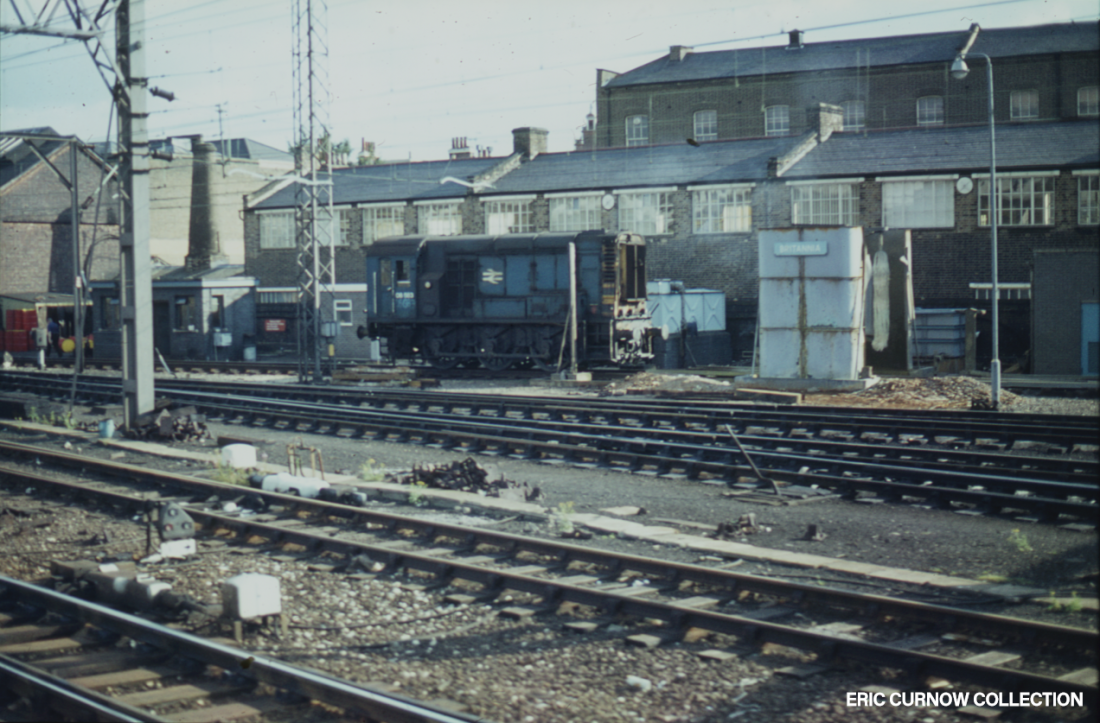
I only occasionally went north up the Camden Bank towards the ex-loco shed roundhouse from Euston, but remember this scene distinctly – though usually there was only through main line traction on the closest tracks, and the shed behind to the left became increasingly unused by rolling stock. 08681 is parked up on the west side by the washing plant. 8008##A01-CDN-08681-PARKD

Workmen unload timber from a rake of open wagons at Boscarne Junction on the ex-GWR line to Bodmin General on 19th May 1964, prior to building Bodmin Exchange platform. This was a carriage-length temporary affair for trials to downgrade the track to the left of this point from through trains to a mere shuttle service to Bodmin North – the ex-LSWR line. 640519A01-BOS-WAGNS-UNLOD

Taken from above the portal to the short tunnel east of the station, “goodbye’s” are said as 47498 awaits pulling away with a Midlands service from Redruth on 17th August 1974. The long building to the left is the railman’s social club, and on the hill behind is the engine house of Wheal Uny. The disparity in the loco’s buffers suggest a recent replacement of the nearer one. 740817A01-RED-47498-PAS_U

Just east of Liskeard Station, D1051 “WESTERN AMBASSADOR” – presentable, other than its exhaust-caked roofline – ‘digs in its heels’ to take forward the 1A85 Paddington service on 12th July 1976, scheduled to have departed Penzance at 3pm. Weak sun lights the foreground, but the sky shows turbulant cloud behind the electricity pylons and telegraph poles. 760712A01-LSK-D1051-PAS_U

Parked before the fitting shop at Long Rock is D1054 “WESTERN GOVERNOR”: its work-work solidity contrasting with the frayed infrastructure behind it. I think it was the sheer bulk of the ‘Westerns’ that endeared me to them – also resembling the GWR-era steam locos they replaced, … for instance, in the common ratio of the height of the number and nameplate sets. 750810A01-LRK-D1054-FUELG

In strong sunshine the driver of D1036 “WESTERN EMPEROR” looks back as the locomotive prepares to move off from Bodmin Parkway Station on 18th August 1974 with the 1A09 1540 Penzance – London Paddington. It has stopped beyond the platform so as many carriages as possible can be “platformed”, and the space to the left shows where lrack has been lifted. 740818A01-BAD-D1036-PAS_U

The ‘doyen’ of the class – 7801 “ANTHONY MANOR” – replete with “light engine” headcode, sets back into a train of a hotchpotch of vans at the crossover just east of Ponsandane Signal Box. It oozes steam and is in a half cleaned condition – its buffer beam number now rather faded. Nationalisation occurred 9 months earlier, but has yet to make an impression here. 480901A01-PON-s7801-SHNTG

‘Out of the box’ and with hardly an exhaust stain on its roofline, D601 “ARK ROYAL” – carrying the requisite single white disc ‘light engine’ headcode on its near end – waits prior to moving off; the second man staring resolutely ahead. Visitors stand ambivalently nearby, their proximity suggesting interest, but quite possibly prefering steam to diesel locomotion. 7####GY01-UNK–D601-PARKD

Figures stand stock still, staring at D1046 “WESTERN MARQUIS” as it arrives with the 2B10 local service from Plymouth on 20th May 1972. In the foreground, drifting exhaust, with bodyside panels reverberating and about to leave the platform is D7504 – still in an unkempt two-tone green livery. Beyond the tide is full: in motion and well-lit by the weak sun. 750220A01-PNZ-D7504-UNKWN

Tantilising-close, but on my visits to South Wales I was never able to get to Margam depot, shown here on 5th June 1977. Maintaining and refueling the locos servicing the minerals traffic, on shed at this time were three 47s, two 37s and a Peak. Despite the downturn in traffic, this shed remained active, and even grew in importance as others closed around it. 770605A01-MGM-DEPOT-VI__S

The ‘home’ is ‘off’ and the ‘distant’ ‘on’ as 5040 “STOKESAY CASTLE” rushes past the goods shed at Ponsandane with an up passenger service. To its right is a restaurant coach, and left the photographer’s bike parked against a telegraph pole stantion. The loco is nicely caught in fairly-sharp focus, while the background is blurred – adding to the illusion of speed. 5####CY01-PDN-s5040-PAS_U

In deep shadow, beside a single DMU on Long Rock shed, D1046 “WESTERN MARQUIS” awaits refueling on 9th March 1975. The distinctive broken window in the fascia of the shed is clearly seen, breached to fit a pipe through, and never repaired. The absence of a sign above the adjacent fitting shop door shows ‘Liftec’ engineering have vacated it by this time. 750309A01-LRK-D1046-PARKD

253014 snakes through a wooded location reminiscent of the view from the railway overbridge close to Restormel Castle near Lostwithiel on an up service. The W.R. HST sets were seven car rather than nine as on the E.R., I imagine because the intended loadings were lighter (for most of the year) and to facilitate unassisted climbing of the Devon banks. 8####BT01-UNK-~3014-PASGR

2-6-2T 4566 waits on the apron before Long Rock shed on 2nd April 1961. Behind it is 0-6-0T 6433, a named 4-6-0, a water crane, the sand drying hut, ends of the air raid shelter and turntable, and stock parked on Ponsandane Goods. The whole site is spotless, showing a commendable standard of respect for the railway industry. Copyright – Steve Healey. 610402A01-LRK-s4566-PARKD

The nameplate of ‘Deltic’ 55017 “THE DURHAM LIGHT INFANTRY” fixed midships to one of the locomotive’s sides. The text of these plates was cast in differing ‘regular’ or ‘condensed’ fonts, and although they featured names of regiments or racehourses, the subject didn’t determine the style. This plate was screwed, not bolted – perhaps inviting theft? 8####BS01-UNK-55017-NMPLT

I don’t know which class of locomotive the control desk is from, but by the angle of the drop light window and the curve of the windscreen, it seems possibly to be an English Electric Type 4. It is in typically grimy and worn state, though the instrument panel backing plate and window surrounds – normally out of touch from the seated driver – are presentable. 7####GW01-UNK-UNKNN-CTRLS

D1044 “WESTERN DUCHESS” in maroon livery is given the all clear to enter the Old Oak Common in the twilight of a day in May 1969. High behind the retaining wall is the canal and towpath that gave a good vantage point for scanning the depot and in the left distance one of the signal boxes soon to be replaced by a power box to the photographer’s left. 69####A02-OOC-D1044-LIG_U

Construction work is still continuing on the Westway road through west London as D6340 heads out with the 5A37 freight in 1969. The loco is in initial rail blue livery with seriffed ‘D’ prefix to its numbers, and in the evening gloom behind there is a ramp and loading platform that a ‘Door to Door’ container is parked against. New flats are also mushrooming behind. 69####A01-RGH-D6340-GDS_D

In rather unkempt appearance, D1023 “WESTERN FUSILIER” leads a train of china clay hoods on the down main through the Fowey Valley just north of Lostwithiel, where storage sidings appear both sides of the lines. Near the centre of the scene, Fresian cows are camped together in the corner of a field, and Restormel Castle is on the skyline behind. 760516A01-LOS-D1023-C_CLY

Following on from the previous photograph, as this is apparently D1023 “WESTERN FUSILIER” again, it seems that the train has been set back into a siding pending movement elsewhere – possibly down to Fowey. Unlike the opposite siding that has china clay residue all over the track, it seems that this particular track doesn’t often hold loaded trains. 760517A02-LOS-D1023-C_CLY

D1033 “WESTERN TROOPER” and D1035 “WESTERN YEOMAN” are seen near Bodmin Road with the 4M05 12.50 Penzance-Crewe Parcels on 22nd July 1976. Both locos came off at North Road, and Trooper worked back to Penzance. Rather surprisingl,y telegraph poles with wires still line the trackside, apparently in use after general removal elsewhere. 760722A01-BOD-2X52s-PCL_U

Seabirds scavage for food as waves lap in on the tide while D1033 “WESTERN TROOPER” smokes away, waiting to proceed to shed at Penzance in 1967. The locomotive is in poor external condition, and it is obvious from the bleached roof panels that all is not well with the exhaust. The state of the platform surface requires some significant rectification as well! 67####A01-PNZ-D1033-LIG_U

With a full bunker, GWR Modified Hall 6921 “ATHELHAMPTON HALL” is parked up against a 2-4-4T on the coal road to Laira Coaling Stage, as a SR 4-4-0 steams quietly beside it. Clumps of wild flowers and puddles have formed around the grime encrusted ballast, and long grass covers the mound. In the background is the hilltop of Mt Gould and electricity pylons. 6####GW01-LAI-s6921-PARKD

It is misty as D1059 “WESTERN EMPIRE” comes off the Newquay branch as it pulls into Par Station with a through service to Paddington in 1974. The distinctive semaphores stand sentinel beside the Signal Box as the signalman hurries to collect the tablet as the engine passes. Below the right signal is the chapel that the siding beside it got its name from. 740912A01-PAR-D1059-PAS_U

A calm familiar scene to me of a ‘Western’ – in this case D0163 ‘WESTERN MONITOR’ – slowing with an up evening passenger at Redruth in 1974. Its surroundings are softened by vegetation, and the silhouette of Carn Brea Castle and Basset Monument are clear against the sky in the background. All is quiet in the empty street below the embankment. 19740912A01-PNZ-D1063-PAS-U

In the late afternoon sunshine of a day in 1974, D1048 “WESTERN LADY” and a Class 47 loco mirror each other as they await departure – the Western with an up passenger and the Brush with a freight. In the area just inside the sea wall a bulldozer is at last removing the ballast and remaining track disconnected from the system and out of use for decades. 740910A01-PNZ-D1048-PAS_U

An 0-6-0 Pannier Tank and a ‘Hall’ class are in the forefront of a picture of the back of Southall Engine Shed in October 1959 – a large number of ex-GWR locomotives are in view. The large ventilators on the many roofs of the depot were most distinctive of this location, as was the huge Gas Holder in the far background. Photo: Photomatic Ltd. 59####A01-STL-LOCOS-PARKD

Captured on film by John Vaughan, long term allocation 08641 rests in the sunshine on the short loop opposite Penzance Signal Box in 1979: in the background another 08 is coupled to the Royal Mail set in Sloper’s Siding. The gap between the older and newer walls is clearly seen – the missing capstone of the former made it easier to clamber on to from track level. 1979####A01-PNZ-08641-PILOT

Castle Class 5069 “ISAMBARD KINGDOM BRUNEL” pauses at Bodmin Road Station on its way west – a train of GWR-style “chocolate and cream” carriages behind and BR “blood and custard” beside it. The long curved nameplate was probably the longest in service, and although not in ‘pristine’ condition, the brasswork all over the locomotive still gleams. 5####CX01-BOD-s5069-PAS_D

The bright red numberplate of 9789 draws the eye as the shunter runs slowly backward before the coaling tower at Oxford depot, the driver watching carefully its progress towards connection and a mate walking beside to hook up. Silhouetted on the mound behind are mineral wagons of loco coal, and adjacent a classmate to the shunter, with enthusiasts. 1965####A01-OXF-s9789-SHNTG

At Treverrin east of Par, 47052 heads a six coach 14.40 Penzance to Paddington passenger service sometime in 1974. It still has an operational and neatly configured headcode panel, and is in original two-tone green livery. Telegraph wires rise ahead of it indicating the closeness of the portal of the tunnel – the vantage point for the photographer. 740822A01-UNK-47052-PAS_U

Visible splasher nameplate supports and a painted number show this Hall Class loco is withdrawn and waiting disposal, at Oxford on 13th March 1966. Its general appearance suggests it to be otherwise sound – intact connecting rods hinting perhaps that removal is not imminent. The area of reeds and osiers beds behind point to this being at the north end of the depot. 660313A02-OXF-s7914-PARKD

A flock of pigeons sun themselves on the roof of what was once the pumping station at the east end of Brunel’s atmospheric railway, but at this time houses a boating business. It is built of large blocks of Devonian New Red Sandstone, and a broad gauge size arch suggests that was where the track once ended. A Class 254 HST running southwards passes by. 8####BR01-SCS-BLDNG-VI__N

The tight bend of the lines out of Paddington are clear in this picture looking back into the station from the LT platforms, as a Hammersmith tube draws away westwards. In the background is a Class 31, probably either removing passenger stock or taking out a commuter service. The massive girders above support ancillary buildings and the inbound taxi road. 7####GV01-PAD-Under-PASGR






London Transport Underground and “Widened Line” traffic passes through Farringdon station in the late 1960s. One of the ‘Cravens’ DMUs has ‘Welwyn Garden City’ in its destination blind, and 31429 is identifiable. The goods yard beside the station has been converted to a car park, although a refuge siding remains. A lot of underground tunneling to the city area remained nearby, too.



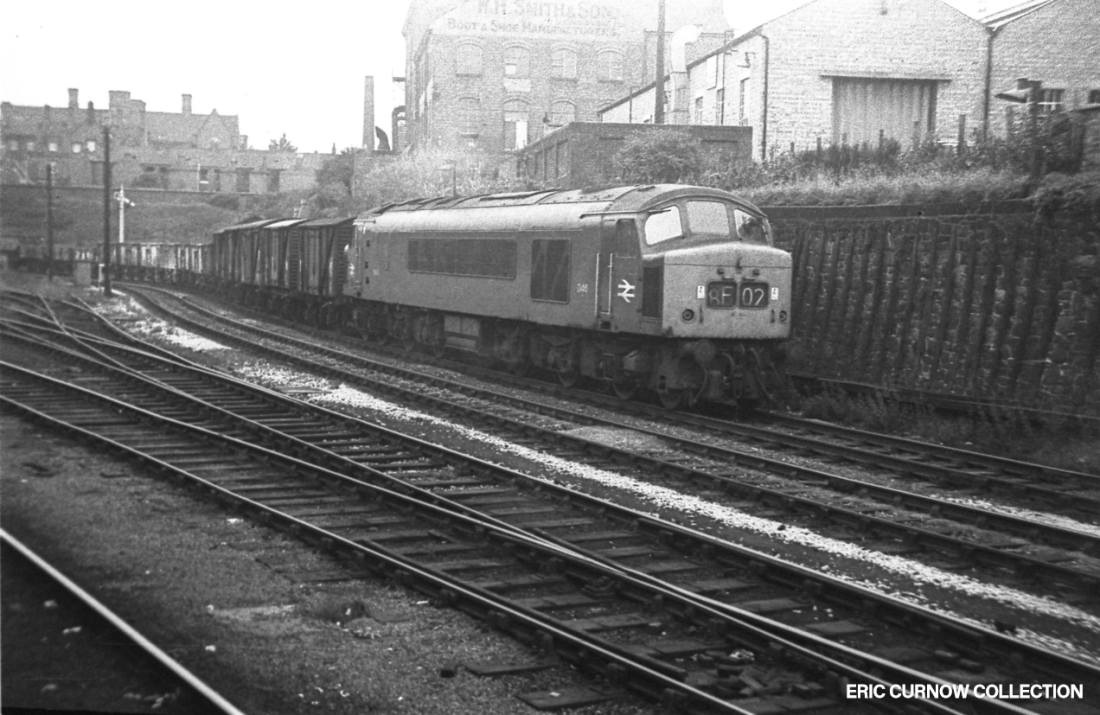

These locos are taken at a location unknown to me, of 45/46s and Class 20s. The signals are upper quadrant and the signal box looks to be of Midland origin; the platform signal box is quite distinctive, too. The lead “Chopper” is D8064 in green livery (it’s compatriot is in blue), and the freight loco is D46 – the stations have a mixture of totem and BR signage, suggesting ‘The Changeover Years’.
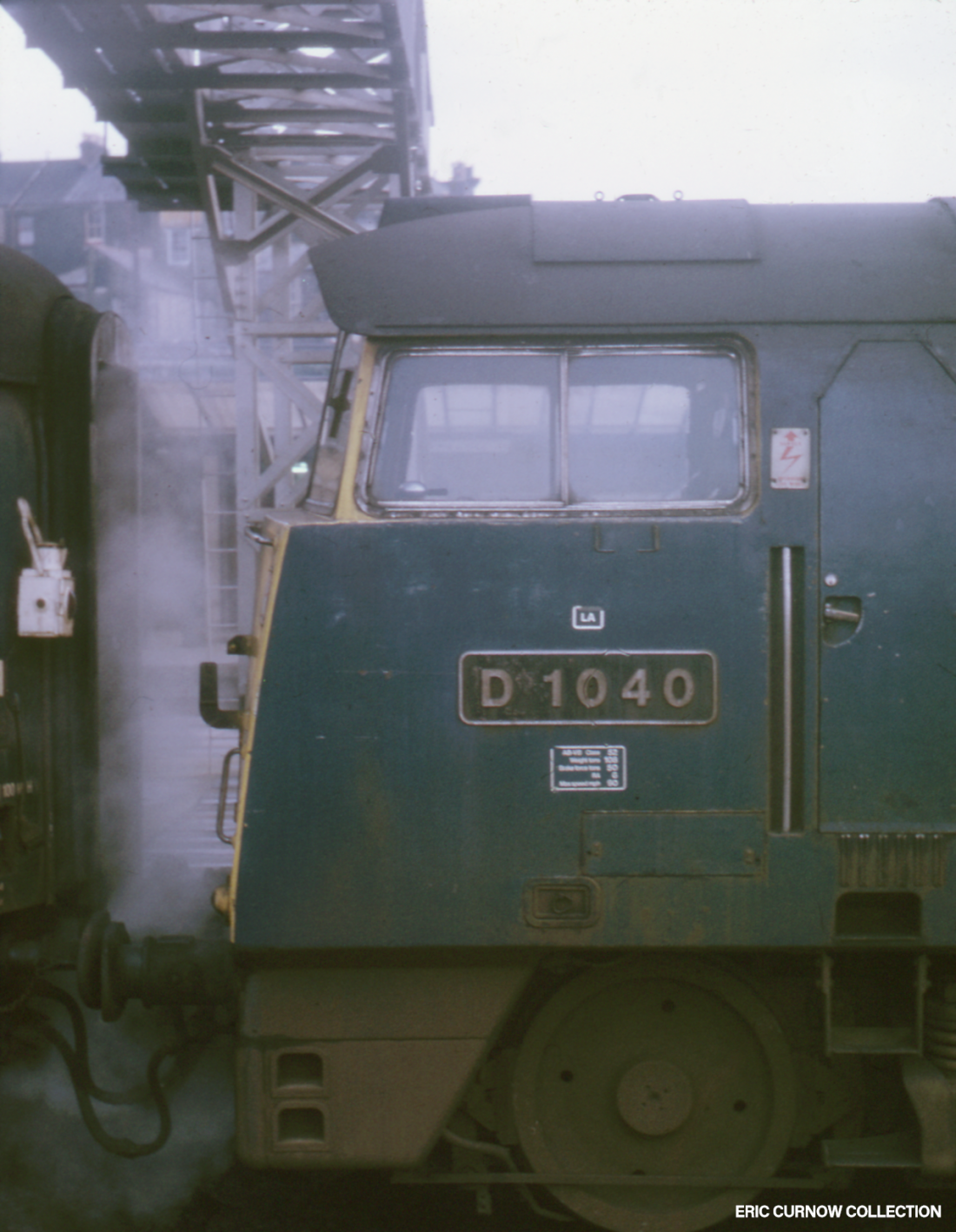
D1040 “WESTERN QUEEN” is pictured at Plymouth with a passenger service under a signal gantry and with excess steam for heating billowing from the loco. The connected carriage is a Mk2, and carries an ‘end of train’ lamp, so with this and the empty cab, it’s not quite certain what duty the ‘Western’ is performing. ‘QUEEN’ is in typical condition for 1974. 74###AP01-PLY-D1040-PAS_D

5016 “MONTGOMERY CASTLE” backs in to Paddington from servicing on 11th June 1962 prior to taking out the Paddington to Neath General relief service. It displays the requisite single left lamp on its front end for the short journey and has a high sided tender piled with coal. In the background are the roofs of the station, empty platforms, and platform awnings. 620611A06-PAD-s5016-LIG_U

A view across the platforms north eastwards at Paddington Station shows 2-6-2 Tank 6141 being watched by spotters near the end of No. 9 – the loco steaming quietly and probably riding in to withdraw passenger stock to Old Oak Common. Parcels Office and taxi road offices are at the far side of the station – the parcels warehouse being a short distance behind. 620210A01-PAD-s6141-LIGHT

Deserted platforms surround BR-built 0-6-0 pannier tank 8458 wearing a No. 2 ECS disc as it pulls stock into Platform 2 of Paddington Station on 11th June 1962. Passengers watch from the rake of Mk1s in chocolate and cream livery, beside it, and platform awnings, offices, signal box, gantry, and girders of Bishops Bridge complete the picture. 620611A05-PAD-s8458-E_C_S


A fireman trims coal on top of the tender of 6020 “KING HENRY IV” as gentle plumes of steam rise from the loco that has arrived with the 12.10pm service from Birkenhead to Paddington on 11th June 1962. Train spotters admire the loco and an array of trolleys await use behind them, but generally the platforms beside it are pretty deserted. 620611A03-PAD-s6020-PAS_U

6011 “KING JAMES I” arrives at Platform 10, Paddington Station, on 19th September 1961 with the 7:40am Birkenhead Woodside to the capital. It has a reporting code frame on its smokebox door, but no letter plates. As it oozes light steam, it is admired by a pedestrian and behind it parcel sorting is going on, with sacks and trolleys clearly visible. 610919A01-PAD-s6011-PAS_U

In two-tone green and new to traffic, Hymek D7084 waits at the end of Paddington’s Platform 3 with the down 5.55pm Paddington to Swansea on 11th June 196(2/3?). Rail enthusiasts on Platform 1 are attracted to some sight high above, and tea urns and corridor connection doors lie on the platform between them and the loco for reuse on later services. 620611A02-PAD-D7084-PAS_D

4096 “HIGHCLEVE CASTLE”, allocated, as the smokebox door ’81A’ shedplate shows, to Old Oak Common three and a half miles back down the track, has arrived at Platform 9 with the 12.05pm Hereford to Paddington on 10th February 1962. Before it is an admirer, and behind is a ‘Warship Class’ diesel in green livery, and an empty parcels area. 620210A02-PAD-s4096-PAS_U

Mailbags are being removed from the brake composite immediately behind 6835 “EASTHAM GRANGE”, recently arrived with the 1A85 1.58pm from Weston Super Mare Locking Road at Paddington on 24th June 1961. Though the stock is maroon Mk1, the curved roof ends of the carriages in the background seem to be pre-Nationalisation Hawksworth designs. 610624A01-PAD-s6835-PAS_U

Three brake tenders are parked together out of use on sidings, judging from the mineral wagons and semaphores in the distance, possibly somewhere in the north of England. Snow has fallen, and there is little in the picture to soften the harsh dominance of metal. Presumably as so parked the brake tenders were largely out of general use at this time. 7####GU01-UNK-B_TDR-PARKD

Newton Abbot Shed is shown pre-demolition on 16th March 1996 when the track beside Platform 1 was being relayed, the rest beside it having already been lifted. Undergrowth is profuse beside the buildings that still appear intact, and sleepers are neatly piled beside the track awaiting reclamation. Piles of ballast and lighting arrays for night work are also in sight. 960316A01-NTA-T_BED-VI_SE



Excess steam heat from 50035 “Tiger” pervades the area before the stop blocks at journey’s end into Platform 2 at Penzance – the formation of GUV and Mk1s still common in the 80s. The levers for the nearby pointwork for releasing locos from Platform 3, and the railhead gleam of the track itself beyond the AWS ramp, show that such operation was still in use then. 8####BQ01-PNZ-50035-PAS_D

6817 “GWENDDYR GRANGE” hauls a parcels van towards Ponsandane Crossing in 1951 – amply powered for this task, but likely to have stock added behind it as it makes its way up line. Behind it, the land belonging to Ponsandane House is luxuriant, and before it the cutting side is resplendent with wild flowers. In the far background TPO stock waits in Sloper’s Siding. 51###AC01-PON-s6817-GDS_U

D811 “DARING” with steam-era headcode boards on its front end races through Swindon with a non-stopping passenger train of chocolate and cream coaches in 1963. Behind it the station building appears to have been extended with a lighter brick portion, and before it, the base of a water crane suggests recent removal of that fixture no longer required in the diesel age. 63###AJ01-SWI–D811-PAS_D

A mist rolls in off the sea at Long Rock depot in 1968, the year before I began visiting and saw such scenes as fairly commonplace. D1012 “WESTERN FIREBRAND” and a Class 22 are hedged against Penzance breakdown train vehicles, awaiting duties on one of the former steam shed roads, the trackwork beside it obviously in the process of being “rationalised”. 68###AI01-LRK-D1012-PARKD

Smoke and steam rise from a ‘Castle’ in fine external condition – possibly 7023 – parked outside one of the sheds at Worcester, with 0-6-0s 9400 and an LMS ‘4F’ behind. I never went to Worcester until recent years, and found it a “pale shadow” of what it had once been. Tenders are piled high with coal, and a water crane and inspection pit are in the foreground. 6####IL01-WOR-s7023-PARKD

Home and Distant signals are down as 6949 “HABERFIELD HALL” rounds the curve at Marazion Marshes with a down carmine and cream coloured train in 1951. Of interest for me are the sidings each side of the track which I never saw – those to the right with cattle wagons for the broccoli traffic, and those on the nearside with a couple of dozen wagons. 51###AB01-MZN-s6949-PAS_D

Vans are parked across the front of the parcels platform at the end of Paddington Station as a Western crosses the pointwork from the Ranelagh stabling point, light engine, towards the terminus; it is followed by an inbound DMU service a couple of tracks away. The main BR building still is partially propped up from the demolition of buildings adjacent to it. 7#####AB01-PAD-D10##-LIG_U

A rather grimy Crewe-built Western prepares to set out across the Royal Albert Bridge opposite Saltash in the 1970s. Beside the Permanent Way Shed, the trackwork split into up and down lines, though now the divergence is farther back towards Plymouth, and the signalling cable runs indicate the closure of the signal box that is out-of-sight to the loco’s right. 7####AA03-RAB-D10##-VI_NW

A view of Menheniot station from an up passenger service – the distinctive station building covered by a projecting roof of ‘Cornwall Railway’ vintage. The signal box is still operative, ‘though the scene has an air of neglect: behind it are the buildings of Clicker Tor Quarry, that until a few years previous to this August 1973 picture provided ballast for the railway. 7308##D01-MEN-STATN-VI__

A misty view of the station and trackwork from the overbridge at Par looking west, with a couple of scissor crossings, plus a spur to the right where the station pilot rested. In the distance beside the nearly hidden signal box lurks a Class 25, and the space to the north of the site has been cleared of the loading paraphanalia, where once a pre-GWR goods shed existed. 7308##C01-PAR-STATN-VI__W

Displaying ‘express’ headcodes, D801 “VANGUARD” heads the up mail train at Penzance Station on 15th June 1959. Although the tracks before it are empty, those behind include a couple of small bromine tanks and a larger milk tank. The quay line is still in situ but truncated where a few buildings are seen, and which are soon to be demolished in redevelopment. 590615A01-PNZ–D801-R_MAL
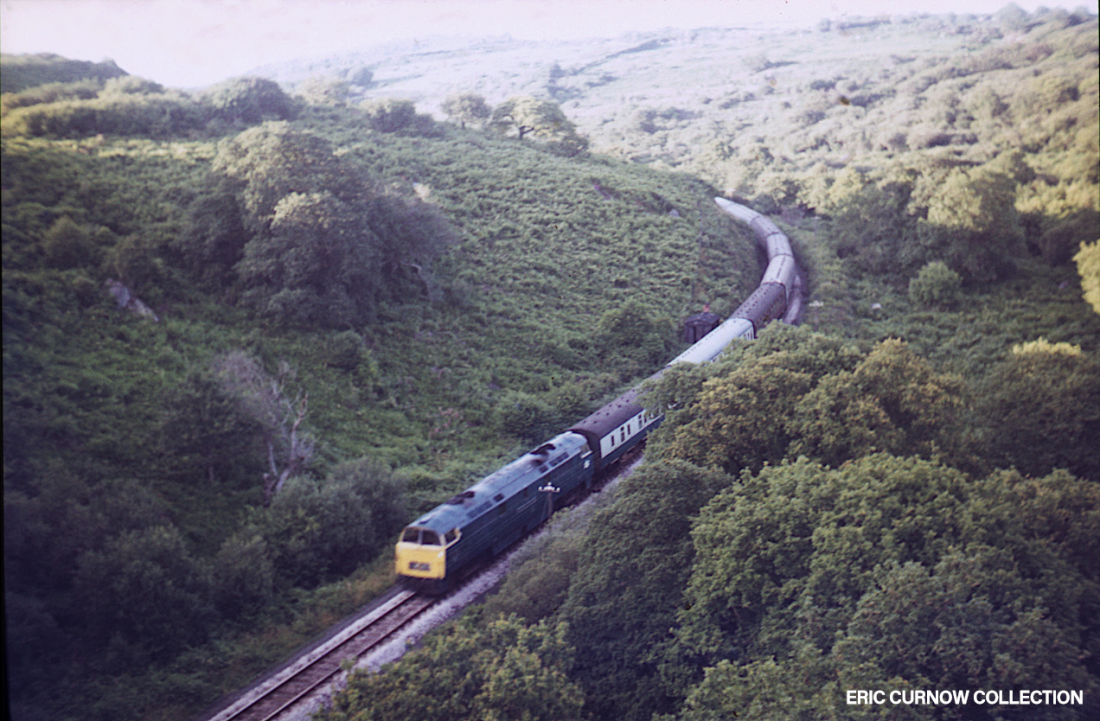
A ‘Western’ is pictured descending towards Par from Newquay – the loco is in recent-Works condition, and many of the coaches behind are in a similar condition. Although recently ballasted, the track beween the rails has been coloured brown by leaking oil from trains struggling against the gradient as they climb towards China Clay country. 71###AC02-LUX-D10##-PAS_I

A view of the Luxulyan Valley from the Treffry Viaduct as ‘Warship’ class 809 “CHAMPION”, still in maroon livery, takes the 09:50 Paddington to Newquay under it in the Summer of 1971. A profusion of foxgloves pokes from the ferns and undergrowth in different places, and bushes and trees jostle for space, cramming themselves close to the recently-ballasted line. 71###AC01-LUX–d809-PAS_I

Exhaust smoke drifts eastward from 31901 – one of Maunsell’s ‘U’ class – with a local train bearing a Padstow headcode, as it struggles along an embankment close to Wadebridge on 12th August 1961. The association of well-kept trackway and indifferently maintained train was typical of this era showing pride in local work, but ambivilence to assets from elsewhere. 610812A01-WBG-31901-PAS_D

A train of Mk1 stock, Par-bound, passes Luxulyan station in August 1973. It retains two well-maintained GWR running-in boards, a pagoda waiting shelter, broken-off gas light column and little else beside. The platform-edge safety stripe only extends a few carriage lengths, indicating the normal alighting area: a very isolated and potentially dangerous station! 7308##B01-LUX-STATN-VI_NE

With its ‘D’ prefix painted-out, and in very reasonable external condition, D7028 is parked with a brake van on a siding parallel to the station platforms of Newton Abbot station. Behind it are the GWR ‘Ocean’ coaches preserved by publishers ‘David & Charles”- ‘Centenary’ stock from the Cornish Riviera Express, that were a welcome landmark here for many years. 7####GS01-NTA-D7028-PARKD

827 “KELLY” is withdrawn, stored, at the back of Newton Abbot depot, with its nameplate missing, and in the company of another Class 42 engine. “KELLY”, like a cluster of those numerically before and after it, was a frequent visitor to Penzance, and memorably to my recollection paired with “JUPITER” or “INTREPID” on various different occasions. 7####GT05-NTA-d827-PARKD

Sometime before willows obscured the view, “81D” is seen from the DMU depot above it near Reading West station. On shed are two SR 33s, a Western and a Warship – dating it to before 1972. Reading was always a depot that must be viewed as I passed it, as besides locos, it also had interesting civil engineering vehicles parked in the sidings alongside. 7####GT04-RDG-DEPOT-VI__N

The gaze of platform passengers along with a driver of an unnamed Class 40 is taken by the loco’s reversal from the platforms of Aberyswyth station in the 1960s. To the left are carriages of the Vale of Rheidol railway in blue livery bearing the BR double-arrow logo, and an area between each sight where track has been lifted and the ballast smoothed-over. 7####GT03-AYW-CL_40-PAS_D

A ‘Warship’ class diesel pulls away eastwards from Newton Abbot with a passenger service of Mk1 stock, viewed from under the awning of the main down platform. The station still has its maroon and cream signage including the GWR wooden running-in board. Taken in the early 1970s, partially visible is the soon-to-be-demolished coal-fired power station 7####GT02-NTA-PLTFM-VI_NE

D830 “MAJESTIC” is at the end of its existence at the back of Swindon Works in the beginning of the 70s . “MAJESTIC” was one of the half dozen or so that ‘got away’ – withdrawn before my period of interest began. It looks like the best part of its nose has been removed at this stage of its decrepitude. along with nameplate, missing windows, access panels, etc. 7####GT01-UNK–D830-SCRAP

Central in this shot of Long Rock depot among named 4-6-0s in 1955 is 0-6-0 Pannier Tank 8473. An enthusiast friend of the photographer speaks with loco men as a well-behaved boy in wellingtons patiently awaits permission to move on, appreciating the privilege he has of being able to see these huge engines at close quarters. Photo: Stan Brown. 55###AE01-LRK-S_LCO-PARKD

A dismal rainy day finds 50045 and a class mate parked in the short sea siding against the wall at Chyandour in the late 1970s. I was always in a bit of a quandary passing locos as I walked the sea wall, happy to view them closely and feel their warmth and smell, but also wary that a loco man might upbraid me for trespassing from a cab as I passed along beside them. 7####GQ01-CYR-50XXX-PARKD

A view from the seaward lineside sees ex-GWR 4-6-0 locomotives pack Long Rock depot, though only one seems to be in steam. Partially hidden behind the new mineral trucks in the middle-ground is the breakdown train, the distinctive skylights of a tool van rising above the rooflines around it, and the chimney of the sand-drying building is quite prominent too. 61###AI01-LRK-S_LCO-PARKD

A 2-Car DMU waits for passengers at Gunnislake before its return to Plymouth in 1970. The station wears its Southern Region green and cream livery, on an insubstantial building faced with corrugated metal – pre-cast concrete pillars hold up the stove-enamelled running in board. It must have been so disheartening for staff seeing such benign neglect day after day. 70###AE01-GSL-3XDMU-PAS_I

A Newquay-bound train of Mk1 coaches pauses at Bugle on the Newquay branch in August 1973, reminding me of a visit to the village with Penzance AFC in the years I followed the football club. The running in board has the distinctive ‘G’ of its GWR origin, suspended between two pieces of old rail. The loading bank to the left of the photo was a distinctive memory too. 7308##A01-BGL-STATN-VI_NW

Laira allocated 3-Car DMU set P481 is arrived at Gunnislake in 1972. The saw-toothed edged awning of the station building reaches towards the unit above the rough platform edging on the near side and ballast indented with impressions from sleepers of the former passing loop are to its other side. Beautiful views towards Dartmoor stretch away into the mist. 72###AG01-GSL-3XDMU-PAS_O

D1021 “WESTERN CAVALIER”, in maroon livery with soot-encrusted roof, is descending to the Welsh portal of the Severn Tunnel with a mixed freight, passing a similar train, and yet the tail of another on the line from Gloucester converging in the background. Six plank wagons seem to predominate, although covered vans also make up the constructs. 641024A01-STJ-D1021-GOODS

A view still common enough on my early visits to Liverpool shows 6968 and 5577, with a class 47 in the background, parked in the station sidings on 25th November 1972. Beside the locos is the slip road mainly used by taxis from the station, behind the photographer, and with the exception of this road, all is totally different today – entombed under office blocks. 721125A01-LST-d6968-PARKD

At St Phillips Marsh, Bristol, a train of withdrawn Hymeks are parked up on an overgrown siding beside the depot, where a Metropolitan-Cammel Pullman unit is being attended to. Withdrawn 7 months earlier, the headcode of D7054 is damaged and it carries rust and deposits from its outdoor exposure. It was always a pleasure to see Hymeks in this green livery. 72###AG01-UNK-D7###-PARKD

The fireman looks back along the train to check all is well as 6828 ‘TRELLECH GRANGE’ slides away from St Austell on 18th August 1959 with a down service. Passing along behind is the tail end of an engineer’s train of grampus wagons – grampus apparantly being the dolphin family, though I had no idea of that in my railway years, thinking it a ‘geological’ term! 590818A01-SAU-s6828-PAS_D

50001 and a ‘Peak’ loco are pictured parked together on the ‘Outside Road’ at Long Rock depot on 16th August 1976. All seems quiet and calm, excentuated by the rank grass and soft vegetation in the background. Like 50049, the first of the class I saw here, 50001 is in fine exernal condition, suggesting that when transferred it was in fine fettle. 760816A01-LRK-50001-PARKD

The ubiquitous seagull pads around the top of the Heliport bus in Penzance Station yard as it awaits pessengers arriving on the next down service. I remember such a vehicle in blue and cream livery, but this was taken after I’d been in London for several years, at the time when the station building was being enlarged. 8####ZZ01-PNZ-M_BUS-PARKD

A rather damp and dismal day at Penzance Station in the late 1950s – where maroon coaching stock awaits use in most of the platforms. The rear of the set in the centre of the picture has a barier panel added to seal the corridor connection, but by the time I was trainspotting this practice had been generally discontinued. 5####CW01-PNZ-STATN-VI_SW






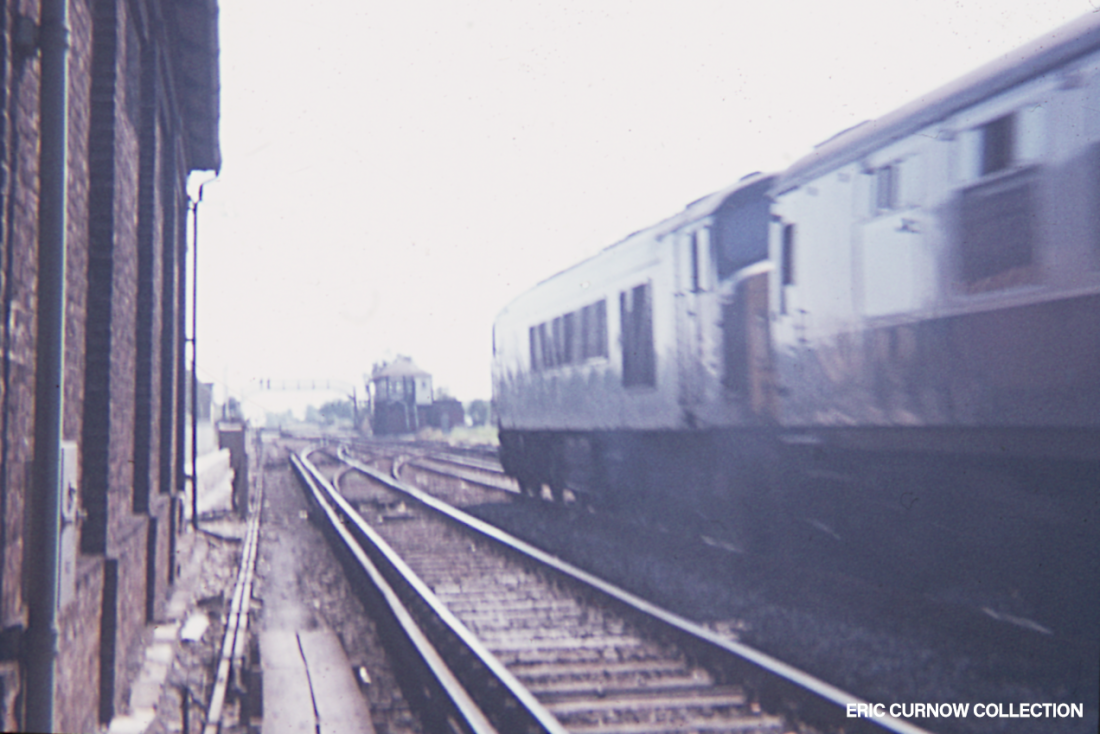
These slides of heavy and bulky ‘Peak’ class 45s and 46s at different locations from the 1979s/1980s were obtained in bulk, and without further identification. Not particularly attractive locos, they resembled their LMS predecessors 10001 and 10002 – which were modelled on 1930s American diesels – and were frequent visitors on NE/SW services, so I saw quite a lot of them. 7####GP01-05

The vegetation in this slide seems very parched as unusual visitor 47201 passes through Ponsandane in the hot Summer of 1976, its headcode turned to “zeros”, hauling an up passenger service. Although the drought made cleaning difficult, a rake of very presentable sleeping cars awaits reuse in adjacent Sloper’s Siding, the yellow stripe indicating first class provision. 76###AN01-PDN-47201-PAS_U

A shunter is pictured between a carriage and 31410 at Huddersfield on 12th May 1984. The loco’s buffers are compressed against those of the Mk2 carriage, so the coupling links can be lifted off the hook and the hoses connected – the ETH cable hangs like the buffer sleeve, chained, until it is required, and the blue star coupling code emblem can just about be seen. 840512A01-HUD-STAFF-CPLNG

You can sense the cold in the air as 50049 “Defiance” waits with an early morning service on Penzance’s Platform 3 in the early 80s. To the right is a GUV from another train; further back down the platform are NCL trailers; and a motorail wagon is at the back end of another down service, on Platform 4. NCL vans are parked haphazardly near the train shed’s left wall. 7####GP01-PNZ-50049-GDS_U
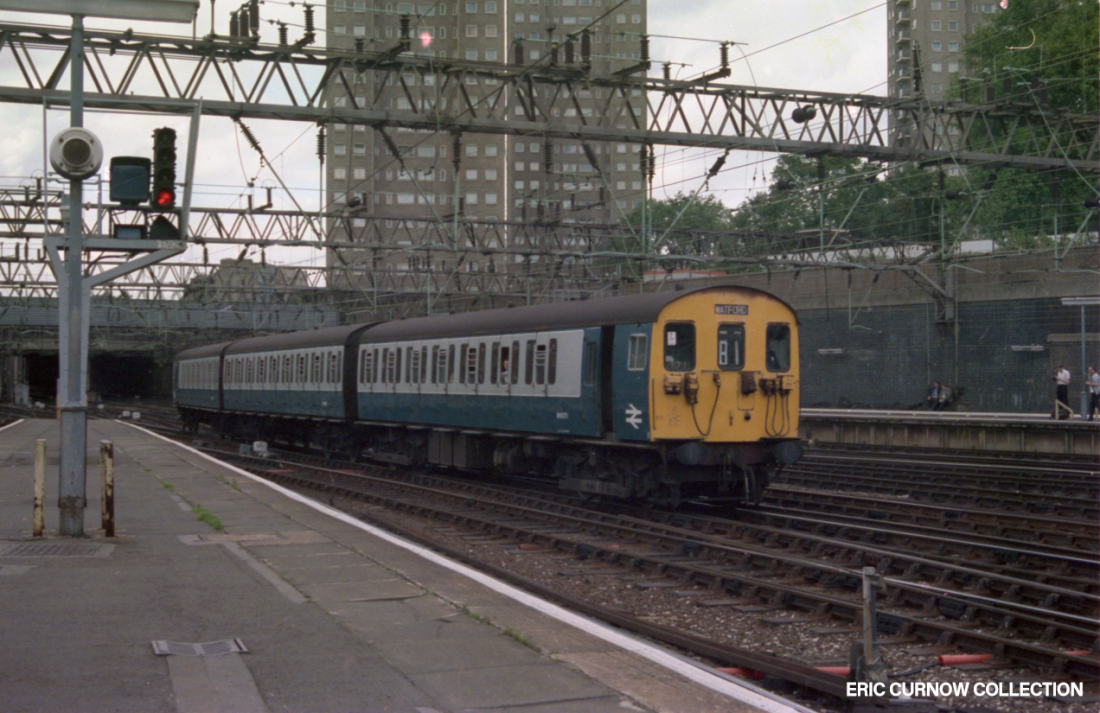
Class 501 501171 (61171 leading) is entering London Euston in the early 1980s as enthusiasts log its arrival in their books. These units were a fairly common sight on my visits, displaying ‘B1″ and “Watford” headcodes. The passenger door windows have had horizontal bars added to prevent people injuring themselves by leaning out of the windows when in tunnels. 8####BN01-EUS-5~171-PAS_U

This impressive view of GWR “Castle” locomotives and a BR ‘Standard’ class at Ranelagh yard, looking towards Paddington, is from an official photograph, showing the locos with headcode boards on their smokebox doors, ready to back down onto their designated trains after servicing. The area today is used for parking cars(!) Photo: R.C. Riley. 60###AN01-RGH-S_LCO-PARKD

43015 in early livery leads an up service at St Erth as the main of the bracket signals at the end of the up platform gives it permission to proceed. The more distant signal is set for departure of a St Ives service, and the Signal Box can be seen just left of centre, with down refuge sidings to the right of it. Repairs to the platform surface have also been recently made. 8####BM01-SER-43015-PAS_U

25236 enters Penzance with a couple of tanks and a brake van in 1974, passing a Western in the Sea Siding and a rake of Mk2 coaches. The wall by the signal never had its capstones in the days I train-spotted there – they can be seen among the track detritus nearby – which was very useful in making the climb onto the wall from track level easier. 74###AO01-PNZ-25326-GDS_D

A telephoto shot of a scene familiar to me is taken in 1974 from St Ives of a departing 3-car Class 116 DMU, exhaust smoking away, about to pass under the overbridge at Porthminster Point. As there is very little on the seaward side of the bridge, it is a wonder such a structure exists, but presumably there was a dwelling there requiring one in times gone by. 74###AM01-SIV-3XDMU-PAS_I

D1051 “WESTERN AMBASSADOR” arrives at Redruth, windscreen wipers waving, on a wet day in the early 70s with the Bradford service. The rain is so heavy even the platform surface under the awning is coated, and Carn Brea is indistinct in the murk beyond. It was quite a pull to lower the signal at the end of the down platform from Drump Lane box! 7####GO01-RED-d1051-PAS_U

08644 is captured at Chyandour bridges on the outskirts of Penzance Station, passing a rake of goods vans in the Sea Siding. The two dumps of less-weathered rocks piled against the wall on the other side were added in the autumn of 1973 to help break the force of strong waves, and the ballast before it is where I rescued a milepost from a refuse fire. 800426A01-PNZ-08644-LIG_U

4181, pictured here on the points near the sea wall to the various bay sidings at the station, was probably the Class 08 shunter I saw most often at Penzance – and certainly the first indicator I had that the ‘D’ prefix to loco numbers was being removed. Coupled to it is a Mk1 brake coach from platform 4, with a telephone point and concrete lamp post to its left. 73###AF01-PNZ-d4181-PARKD

All with their destination codes wound to zeros, 45002 heads a row of Class 25 locos at St Blazey depot, alongside an 08 shunter and a Class 47. A pile of concrete castings have been casually heaped before the depot’s impressive administrative building, and the rooftops of the roundhouse can just be discerned above those of the motive power units. 760626A02-BZY-D_LCO-PARKD

The home starter has already been reset to “off” as a Penzance-bound train of Mk1 carriages climbs away west from Par, alongside D1041 “WESTERN PRINCE” that is arriving with an up service, on 26th June 2023. On the opposite side of track is the boundary fence of GWR-era spearpoint railings, and the path that leads to the allure of St Blazey depot. 760626A01-PAR-D1041-PAS_U

A Class 47 heads the 11.00 Penzance-Paddington at Largin Viaduct on 27th August 1974. At top left can be seen the former double track now converging to form a single line across the bridge and avoid the weight of two trains side by side, prolonging the life of the structure. This area has been extensively reforested, and this view is probably not possible today. 740827A01-LAR-47###-PAS_U

Wearing a Laira (Plymouth) shed plate below its smokebox number, 6849 “WALTON GRANGE” clanks through Marazion Station light engine during May 1958. The station layout is very neat with manicured track, board crossing, reduced-height signal, loading gauge and retaining wall, and the sun, high clouds and deep shadows suggest a fine day. 5805##A01-MZN-s6849-LIG_U

Oxford Station in the state of my first visit in the mid-70s. The station has been mainly rebuilt with new offices and awnings, although the signalling is still semaphore. The awning closest is stained with diesel exhaust as this is where ‘up’ trains’ locos would wait. The tail end of a MkI train is on the stopping ‘down’ road, and BRUTE trolleys await use on both platforms. 730703A01-OXF-STATN-VI_NW

D6309 is in it’s class’ typically poor external condition as it waits in the sidings at Truro Station between duties on 21st July 1970. Its left hand route availability yellow dot has been covered by a data panel, but all else is little changed since its yellow warning panel addition many years earlier. Low loaders of track panels and miscellaneous vans complete the scene. 700721A01-TRU-D6309-PARKD

Didn’t she scrub-up well? This loco once towed roadstone wagons back and forth from Penlee Quarry near Newlyn to the end of the South Pier, but now has been transformed and is seen on the Leighton Buzzard Light Railway. I’d arranged to meet one of my former bosses there once the transformation was complete, but sadly he died between times. 08####A01-BUZ-PARKD-UNKNW

Drizzle is in the air, and puddles are scattered on the landward side of St Ives station’s platform as passengers wait under the awning for their train to be shunted in and made ready, probably in the late 1950s. Poster hoardings, a grounded wagon body and a lightweight building flank the pavement to the right, opposite the track milepost. 5####CV01-SIV-STATN-VI_SE

The environs of St Ives station in the 1950s: its wooden signal posts are recently painted and, with the new bridge, everything looks in good order. To the left is the water tower and engine shed; above the bridge railings is the signal box; and on the right, the goods shed and tail end of a train. There is a nice balance of soft vegetation with the, sadly inevitable, buildings. 5####CV01-SIV-STATN-VI_SE

Before nationalisation had made much of its mark on the station, Carbis Bay still has its GWR running in board, as seen from the overbridge to the south east of the station. The granite building always seemed to be sliding downhill to me from this vantage point, but its existence also gives it an air of importance, later lost in the station’s downgrade. 5####CU01-CBB-STATN-VI_NW

I was scarcely ever out after dark at the railway because there was little chance of identifying locos with the low lighting of the time – and there were numerous trip hazards in the darkness. One memorable exception was passing Bristol Bath Road en route to a Scout camp, that was all lit up with interesting diesels. Here 45048 is parked up similarly in the 80s. 8###AB01-BBR-45048-PARKD

In gleaming rail blue livery, 45048 looms out of the darkness between two lighting columns at Bath Road depot. The line of diesels behind is headed by a Class 31 that, unlike the 45 with replaced nose, still has characters wound up in its headcode. To me, this picture shows the British Rail corporate identity at its best, with a neat contrast of visual components. 7###AB02-BBR-45048-PARKD

Typical of Paddington in the late Seventies are a Class 31 on ECS duties, running back to Old Oak Common, and a Class 50 smoking away before the signal box prior to its visit to Raneleigh or OOC for refuelling. The 50 has been named, and by now its class is performing well, with the teething problems of their unfamiliarity to the WR behind them. 7903#A02-PAD-LOCOS-LIGHT
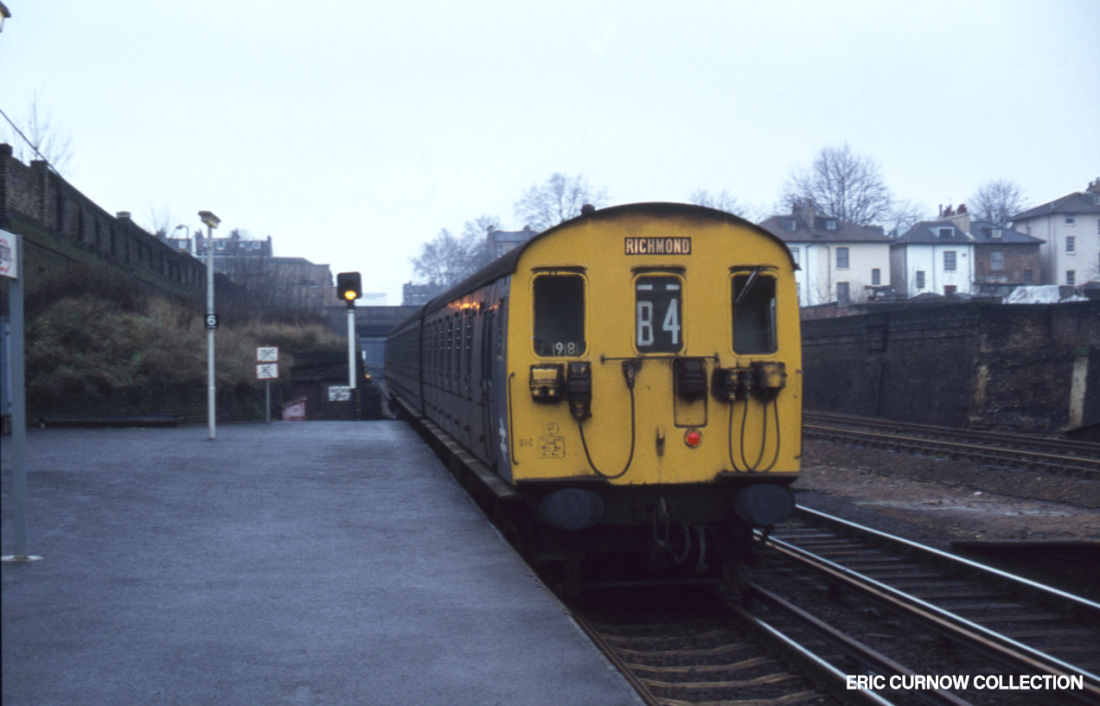
Highbury & Islington Station was a regular transit point of mine – both the Underground, and looking over the BR line from any clear vantage as I passed alongside – particularly in order to see inter-regional freight workings along the North London Line on the far side. A standard design 3-Car EMU passes through west en route to Richmond in 1979. 79###AF01-HHY-EMUX3-PAS_O
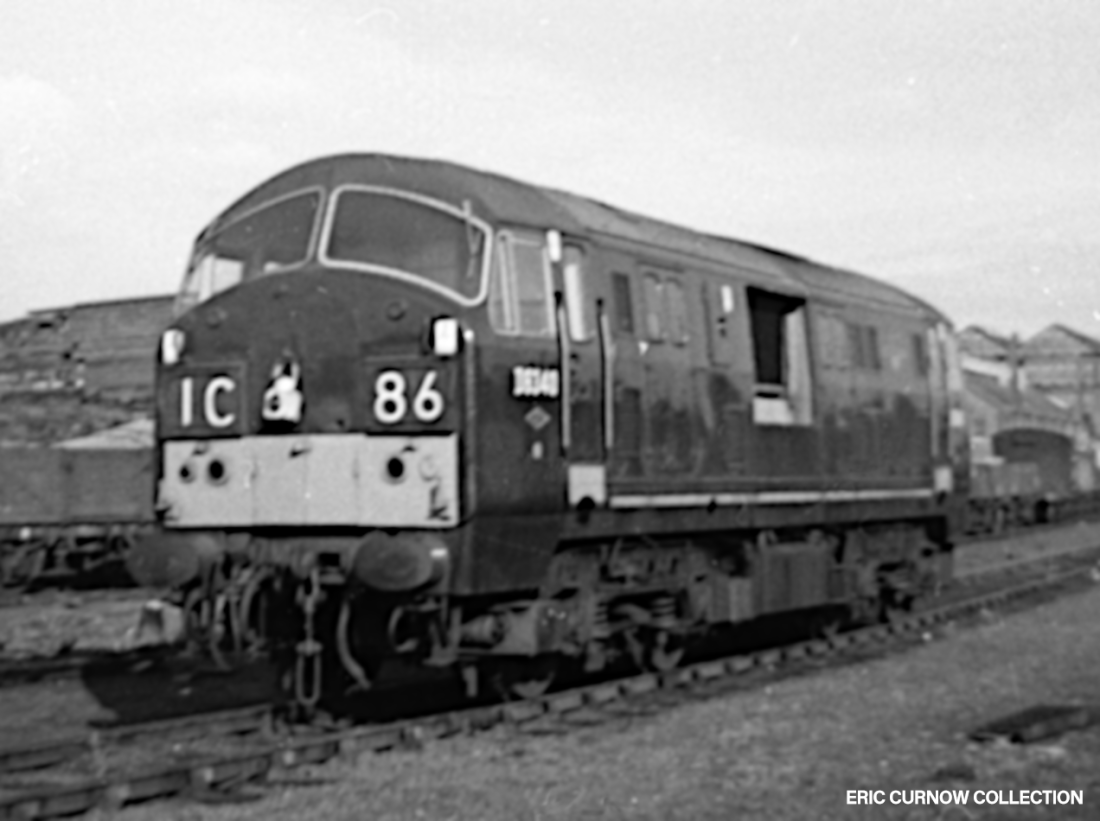
A Baby Warship is parked before a line of 6-plank wagons, with what looks like Swindon railway workshops behind – though I can’t imagine what is to its left. D6340 has recessed split headcode boxes, displaying a westbound passenger service, a gaping hole in its side missing a grille, a casually applied tail light, and a hanging rather than suspended coupling. 6####IG02-UNK-D6340-PARKD
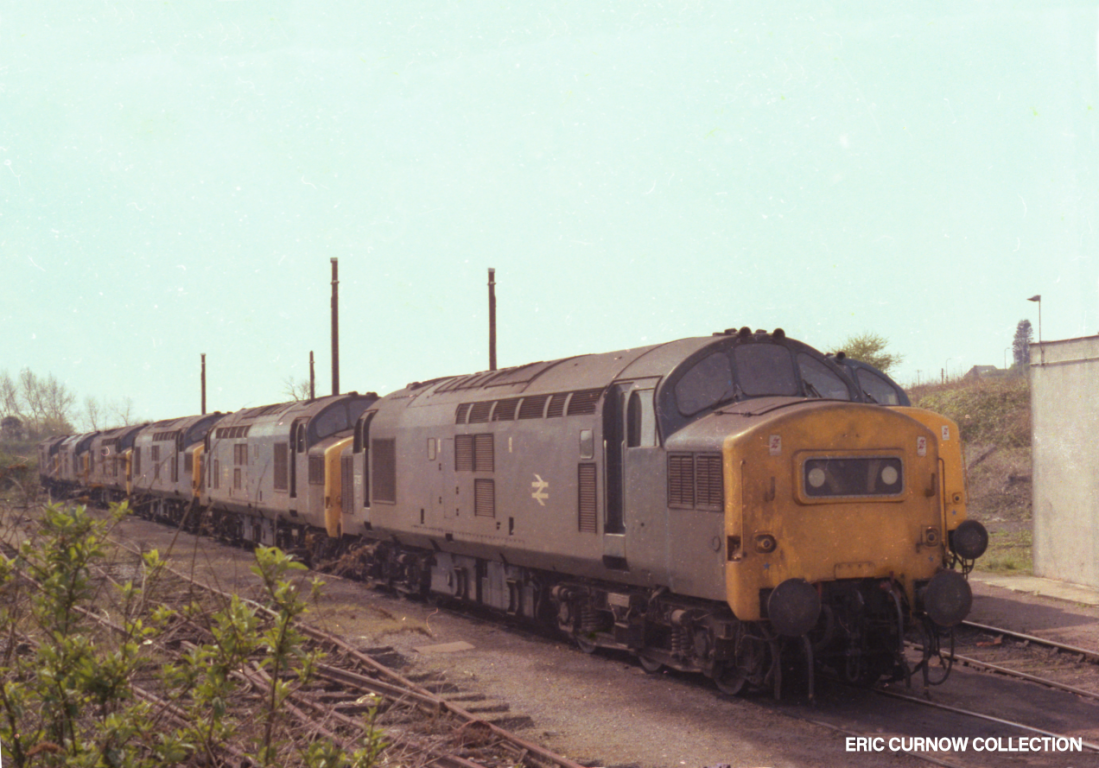
A line-up of two rows of parked Class 37s like those seen by my brother and myself when we followed a track through through a hedge on our first visit to South Wales, during a coal strike. The locos are work-worn but in good external condition, and the nearest has a glass infil panel suggesting the picture was taken sometime in the mid-70s. 7####GN01-UNK-D_LCO-PARKD

A pair of Southern Region 33s are surrounded by WR locos on Canton depot at Cardiff. Men race into the shed at left, presumably to clock in promptly after lunch, as one of the engines opposite starts up. Two Class 46s – one with marker lights, accompany 47523 and a class mate, and the ballast between tracks is packed hard,with litter spread around the tracks. 7####GN02-UNK-D_LCO-PARKD


As shown by their non-standard cab-front numbers, 37234 (left) and 37272 (right) head lines of Class 37s at adjacent sidings in South Wales amid scrub bushes and buddleias. A loco in much cleaner condition tails the line behind 234, and the front engines show interesting nose differences in the position of lamp irons and headboard clips, and even buffer shape. 7####GN03-UNK-D_LCO-PARKD

Holiday-makers enjoy the sun on the beach at Ponsandane and wait either side of the automated crossing as D1001 “WESTERN PATHFINDER” passes with a down passenger train on 14th August 1976. Its headcode has been wound to zeros, and someone leans from the carriage to take in the remarkable view – now sadly marred by high sea defences. 76###AK01-PNZ-D1001-PAS_D

Under a glowering sky, a two-tone green liveried ‘Brush’ Class 47 pulls away from a station in 1976, wearing an experimental headcode surround, presumably intended to help lock the sight of a signalman for easier identification – I saw such experiments a few times. The fencing before it has seen better days, and the whole picture has an air of spartan neglect. 760314A01-UNK-47###-PASGR

In strong sunshine casting deep shadows and masking young trainspotters, D812 ‘THE ROYAL NAVAL RESERVE’ arrives with a down service at Taunton. Even in “green and yellow” days, the central platform has already been denuded of station furniture and weeds grow in clumps. In the bay platform opposite waits a Minehead shuttle DMU. 6####IH01-TAU–D812-PAS_D

A trackside workman operating gas equipment mops his brow, and sun glints off the windscreen of an ex-Works Class 46 as it approaches Bodmin Parkway station in April 1977 with a down passenger service of Mk 2B coaches. To the left, beside the point shunting signal, is a set of catch points, intended to derail any runaway stock from blocking the up main line. 7704#AC01-BOD-46###-PAS_D

The guard of a train of china clay “hoods” looks back to check the integrity of his train as it draws out onto the main line at Par Station in April 1976. The train engine seems to be 25213, and it appears to be transferring to the down main. The carriage/hut to the left is the railwayman’s club, and pipes on the field behind suggest development there is imminent. 7704#AD01-PAR-25###-CCLAY

LNWR 3020 “Cornwall” is pictured at Clapham Transport Museum, housed in the old bus garage there, on 29 May 1965 – a place I visited at least once as a boy. The exhibits eventually went to York as part of the Natinal Railway Museum. The blending of elegance with function of these locomotives of the past still engender admiration today, generations later. 650529A01-CLP-s3020-PARKD

D1063 “WESTERN MONITOR” protrudes from Long Rock Shed on 4th April 1976 in the twilight of the building’s existence. Behind it are Grampus EW wagons of spoil, some of which is dumped before them, and a carriage, back towards the main line. Before it is an external inspection pit and the bricked paving apron surrounding the entrance tracks. 760404A01-LRK-d1063-PARKD

5555 is pictured at Exeter St. Davids on 24th June 1963 parked up with its chimney incomplete and covered, and a sister loco without a safety valve cover – both not yet withdrawn, but out of use and awaiting disposal. They are hidden away from public view behind the Water Tower and a breakdown vehicle, making a rusty contrast with the new signal. 630624A01-EXD-s5555-PARKD

Warship D803 “ALBION” in blue livery proceeds D824 “HIGHFLYER”, still in green, with a service out of Paddington, passing Royal Oak Station in August 1968. “HIGHFLYER” has a lot of brake dust caked to the area below its solebar and is dowdy when compared with its companion, its upper sides pitted with impact damage from flying debris. 6808##A02-RGH–D8XX-PAS_D

Trackwork creaks, and the crew of ‘Star’ Class 4012 “KNIGHT OF THE THISTLE” are anxious to be captured on film for posterity, as the loco trundles off the turntable at Long Rock shed in the 1930s. The shed has short dark stumpy chimneys and it looks like white lights have been positioned on its facade to aid illumination. Copyright: Lens of Sutton. 3####AH01-LRK-s4012-PARKD

The signal board reads ‘GOODS LOOP’ as a Brush type 4 in green livery and a rake of maroon vans passes under the signal gantry across the tracks at the north end of Oxford station. Beyond it are a couple of steam tanks, parked up vans and the old depot building is to the left: front right a maroon enamel sign forbits public crossing on the boardwalk between platforms. 6####II01-OXF-STATN-VIS_N

The crew of 47316, a Sheffield-allocated loco, relax awaiting departure time at the head of an up service at Penzance station’s goods platform in 1979. John Vaughan has captured perfectly its conjuncture with St Michael’s Mount, behind, in composition, sharpness and exposure, and even the “pranged” station furniture on platform 4 before it is also in focus. 79####A01-PNZ-47316-PARKD

The second-man has his feet up on the control desk as D868 “ZEPHYR”, one of the late batch of Swindon-built ‘Warships’, rolls away towards Bristol Bath Road depot in the 1960s. Its green paintwork shows substantial weathering, but remarkably not the bodyside stripe and number added later – suggesting the quality of the dominant paint used is below par. 6####IJ01-BRI–D868-LIGHT

D7502 is pictured at Burton shed on 11th October 1969, a couple of years before I first saw it on Penzance shed, and in much the same condition – sent to replace the D63XXs being removed from WR stock. Its rather rusty, unkempt’ appearance suits its surroundings, and it probably worked paired with its classmate behind, that is still wearing a small warning panel. 691011A01-BUT-D7502-PARKD

On a calm Summer’s day, 6967 “WILLESLEY HALL” brings the ‘Cornish Riviera’ working into one of the arrival platforms at Penzance Station on 19th July 1951. The signalman watches from his cabin, and has already set the train’s approach signal to ‘on’. Though concrete lamp posts are now in situ, the wooden signals have yet to be replaced by tubular steel ones. 510719A01-PNZ-s6967-PAS_D

D821 “GREYHOUND”, which went on to preservation, is pictured in an unidentified location, parked amid rolling stock including oil tanks and a van, perhaps in Westbury yard, in the days before roller blinds wound up in the cab ends were dispensed with. A few spoil heaps of ballast have been accidently spilt around one of the foreground tracks. 6####IK01-UNK–D821-PARKD

I remember coming across this bridge to the east of Oxford Station ten years before it is pictured here and was a little mystified by it, but because of its proximity to the canal and the bridges under the main lines, imagined it was a necessity to enable boats to periodically navigate through the space under it. It was already apparently derelict at that time. 840519A01-OXF-BRDGE-VIS_N

Redruth Station when I was at college there, fairly deserted but very clean and tidy. The station still has pre-British Rail signage, including the matt-finished front-illuminated running in board, and totems on lamp posts. BRUTE trolleys wait around, with ‘Walls’ vans visible, possibly for Drump Lane bacon factory produce rather than ice cream deliveries. 73###AE01-RED-PLTFM-VI_NE

4-car EMU 313008 in Network South East livery runs off the bridge over the main lines out of Euston at Willesden Junction on its way East to Broad Street and Woolwich among locations. Although I passed beneath on quite a few occasions, I only took this line about half a dozen times, from Camden Road just north of where I lived, to look at the depot just south. 980512A01-WIJ-3~008-PAS_I

31402 is pictured crossing the front of York Road station at King’s Cross onto the Widened Lines in the days when there was a commuter station in use there and goods trains running to Farringdon and beyond. The new Power Signal Box has replaced the steam-age one, once centrally situated on the space shown between the tracks in the picture. 76###AM01-KGX-31402-LIGHT

With pantographs lowered, Class 73 electric locos are pictured from an overbridge next to Wath depot in a sight I first saw in a railway book, and hoped one day to see in person (though the opportunity never presented itself). The engines seemed very basically styled to me, and devoid of elegance: which added to their allure and piqued my curiosity. 7210#AH01-WAH-76050-PARKD

Green PWM653 is parked up amid sleepers, a crane and other permanent way equipment before Reading depot in 1973 – a sight I saw a couple of times, though my normal sighting of this shunter was at Taunton later, when in corporate yellow paintwork. A Hymek and breakdown vehicles are separately arrayed behind it, and on the skyline is Reading DMU depot. 780329A01-RDG-P~653-PARKD

At an unknown location, a train of out-of-use Hymeks are parked up on an overgrown siding beside a depot where a Metropolitan-Cammel Pullman unit is being attended to. The headcode of the nearest loco is damaged and it carries rust and deposits from prolonged outdoor exposure. This rake is probably awaiting removal for scrapping elsewhere. 72###AG01-UNK-D7###-PARKD
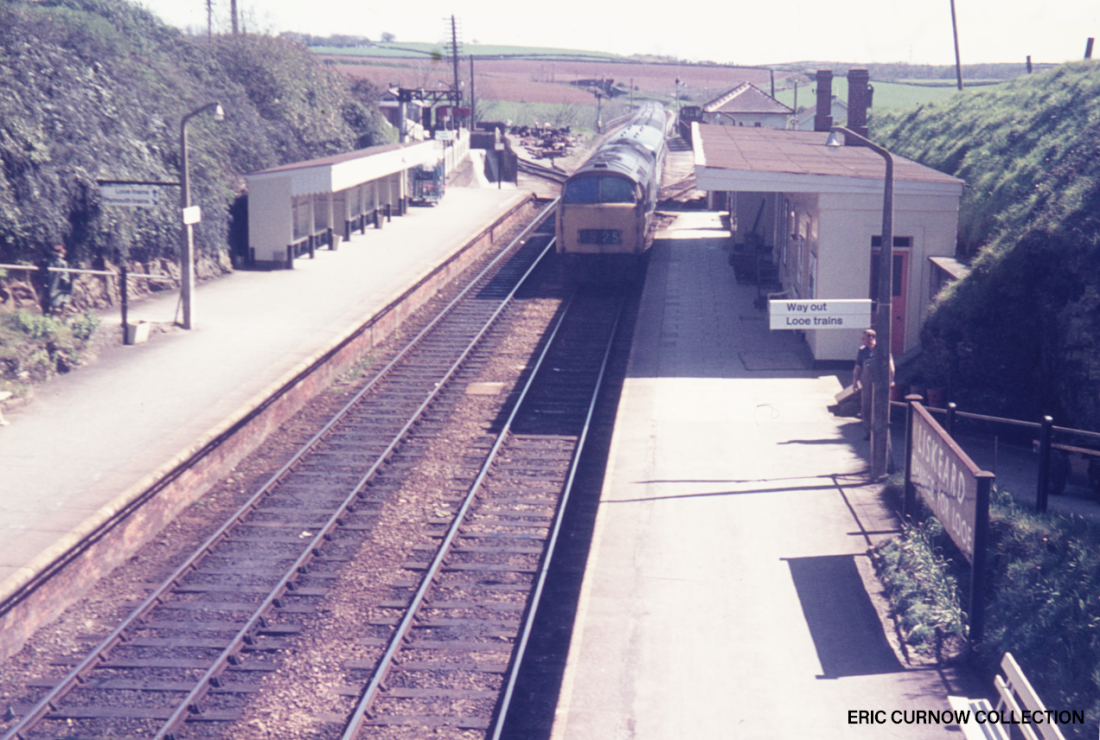
A combination of maroon and white corporate enamel signs flank the tracks at Liskeard Station as a ‘Western’ draws in with a Penzance-bound train. This picture was probably taken in the late 60s / early 70s, sometime before headcodes were abolished and Mk2 coaches introduced. A shiny new coach heads the otherwise dull consist of Mk1s. 7####GH01-LSK-D10##-PAS_D

A dirty Class 50 on a Penzance service with headcode set to zeros slows to pick up passengers at Par Station in 1976 – a drought year when saving water precluded cleaning trains. A rake of Newquay line coaches is on the far side of the island platform, and the bright sun casts deep shadows across it, but lightens the palm trees beside the down platform. 76###AL01-PAR-50###-PAS_D
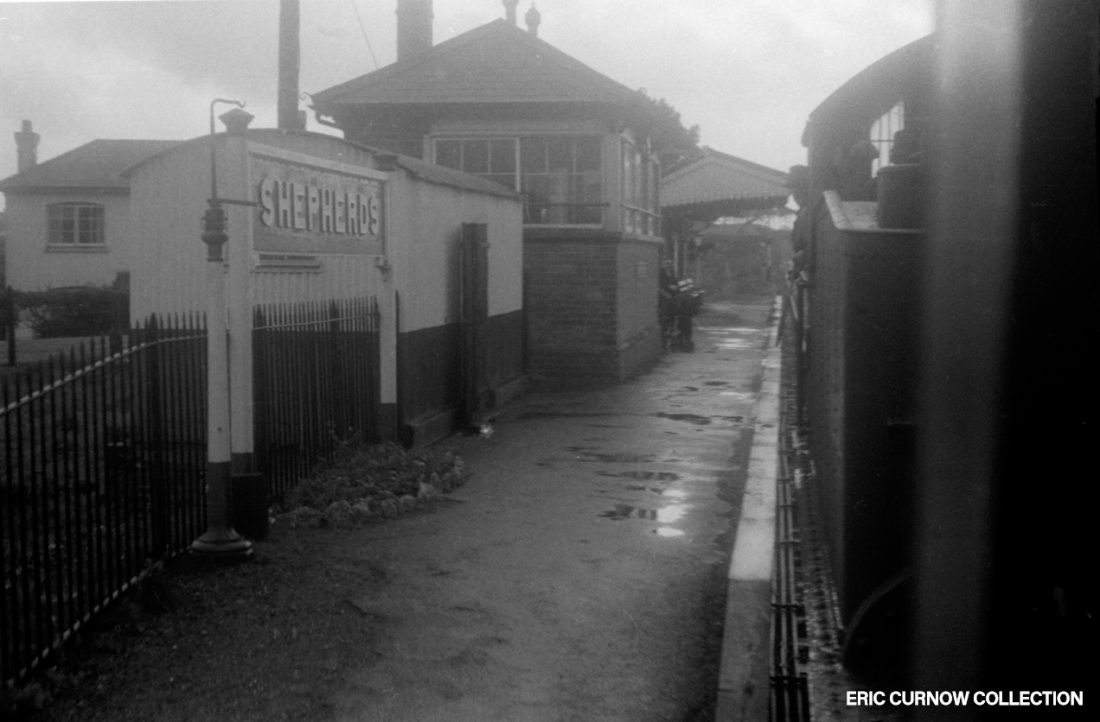
Puddles from a downpour remain on the platform of Shepherds Station as a Chacewater-bound train rolls into it on 26th September 1956. From left to right is Station Master’s House, corrugated iron storage hut, signal box and station building awning. The running-in board has a small flower bed planted before it, and a gas lamp nearby. Photo: H C Casserley. 560926A02-SHD-s45##-PAS_I

A Newquay Service apparently near Goonbell makes its leisurely way hauled by a 45XX tank loco on 26th September 1956. The embankment across this valley is typically overgrown by rank grass and gorse – fresh scree has been added at the far end beyond the platelayer’s hut. A minor bridge underlies the track just ahead of the locomotive. Photo: H C Casserley. 560926A01-GON-s45##-PAS_O

With loaded wagons before it, large ex-GWR tank 6150 pushes them ahead under the watchful eye of the fireman at Oxford in 1964 on the lines to Rewley Road goods station. To the right are the main running lines with track fans opening out into the depot yard, and beyond is the area that mystified me – here revealed as open land and sidings. 640704A01-OXF-s6150-SHNTG

25275 crosses from the up line onto the down at the eastern end of St Erth Station with a couple of tanks and a brake van, possibly from Hayle sidings half a mile further back. The tall buildings are the Creamery, that provided milk tanks for London in a week day service, and before it a scrap merchants, plus largely redundant ancillary goods yard railway buildings. 75###AQ01-STE-25275-TNK_C

The west end of Salisbury Station sees ex-Southern Railway West Country Class 34089 ‘602 SQUADRON” arriving with disc headcode announcing a Plymouth / Waterloo or Nine Elms goods service in 1964. To the left is a green liveried Hymek and right an 08 shunter, shunting the WR yard before the signal box. The loco shed is in the distant right background. 64###AO01-SAL-34089-PAS-U

08573 seems dwarfed by the many sidings of Old Oak carriage depot for storing stock, at a quiet time of the day. The furthest ones are the main lines from Paddington (left) to the West (right) and beyond them Wormwood Scrubs Common – the near side of which was once a good vantage point for the lines, but now houses North Pole depot. 901218A01-OOC-08573-SHNTG

The BR flag flies from the administrative buildings of the world famous ‘Swindon Works’, viewed from the station area, with various vans and Mk1 coaches before it. Across the foreground are the mainline tracks to Bristol (left) and Paddington (right), with the curve into the background heading for Gloucester. A maintenance shed is the modern building to the left. 820922A01-SWW-BLDNG-VI_NW

Three Class 86 electric locomotives head down passenger services as they await departure time at Euston Station on a grey day in 1983 – the year I finally gave up logging sightings. Above the trains is the concrete raft of the Parcels Depot that spread across the whole station, and each of the locos has received metal plate headcodes with inset lights. 83####A01-EUS-E_LCO-PAS_D

The replica GWR broad gauge loco “NORTH STAR” is shown within the works at Swindon, as D8XX ‘Warship’ Class locomotives are built in the background in the late 1950s. Representing a historic original engine, “NORTH STAR” was mounted on a plinth as inspiration for works employees to emulate the standards of the Great Western Railway. 5####CT01-SWW-N_STR-PRESD

Outside the main shed at Old Oak Common Depot Open Day on 15th August 1967 are D1610, D7035, D6354 and D1060 “WESTERN DOMINION”. In the background are canal-side buildings; closer in are large white fuel tanks; and in front rusting brake blocks. D1610 is surprisingly still in pristine two-tone (non-corporate) livery at this late time. 670715A01-OOC-LOCOS-PARKD

The last Warship I got close up to in service was 812 “THE ROYAL NAVAL RESERVE 1859-1959”, and – sensing the imminent end of visits by this class – I took a rubbling of its nameplate that I still have today. Although double-arrow logos were earlier fitted to cab ends, towards the end of their career single ones were positioned below the nameplates instead. 7####AA02-UNK–D812-NMPLT

People climb the steps to what was then the Booking Office cum main street entrance at Penzance Station, while others make their way through the ticket gates onto the platforms, or talk to the man inside Wyman’s Bookstall. Behind the coaches in maroon livery is a D8XX Warship that has brought in an earlier service and a plethora of interesting signs. 63###AI01-PNZ-STATN-CNCSE

Among those milling around the concourse of Penzance Station are girls from the School of St Clare, who wile away the time at Wymans’ Bookstall before their train departs, in 1963. I can only distantly remember Wymans, and believe it was next in the hands of WH Smith (who also had a shop opposite) before it became John Menzies – but prepare to stand corrected. 63###AI02-PNZ-STATN-CNCSE

Class 45xx 2-6-2t passenger tank locomotive, number 4550 looks ready for service before the water tower and coaling stage of Truro loco shed on 13th July 1938. Behind it is a raised area with coal wagons that have been propelled from a slope to the right, and the asymmetrical rooflines at the back are the skylights of the depot building, with chimneys above. 380713A01-TRU-s4550-PARKD

Ex-GWR County Class 4-6-0 No 1027 “COUNTY OF STAFFORD” is shown in early British Railways days beside an unidentified depot building, parked up with other locos. Before it is a scooped-out area of ballast, and the shed behind has glass skylights positioned high above the pitched slate roof, and metal chimneys in the final style of such features. 48###AA01-UNK-s1027-PARKD

Soon after nationalisation’Star’ Class 4016 “THE SOMERSET LIGHT INFANTRY (PRINCE ALBERT’S)” is parked up at Old Oak Common with other locos. Before it lie trackwork on wooden sleepers standing proud of the ballast, and points levers for working by railmen, not signalmen. Lighting towers, telegraph poles, sacks and pipes complete the picture. 49###AA02-OOC-s4016-PARKD

Passengers hurry across the footbridge at St Erth in order to catch the soon to depart Penzance passenger service. Its near cabside logo is low to match that of the far cab that has its number above it: later economy rationalising identity to one emblem amidships was aesthetically far better. Flat bed trolleys wait with flower boxes for loading a later up service. 75###AP01-STE-500##-PAS_D

It looks as if 552 – a Class 120 DMU – is entering Penzance wrong line on this rather gloomy day in 1976 – judging by the signal at ‘on’ and the lack of a red light at this end of the unit. Large chunks of limestone are piled on the seaward side of the wall for protection from the sea, and beyond the ‘National Speed Limit Applies’ signs are trees of Ponsandane Estate. 76###AK01-PNZ–P552-PAS_U

Warship Class D804 “AVENGER” nears Par in 1963 with an up TPO (Travelling Post Office). It is in original green livery with small yellow warning panel and has yet to have its 3-digit headcode framework replaced by a 4-character inset assembly. A lush profusion of brambles dominates the left lineside cutting and wooden fencing uprights the right. 63###AH01-PAR–D804-MAI_U


Alderman Beckerleg, the Mayor of Penzance, greets the cabin staff of the first non-stop train from Paddington to Penzance upon its arrival on 7th May 1966, along with members of the public, station inspector, other counsellors and passengers. D1035 “WESTERN CAMPAIGNER” headed the train and it and its coaches were resplendent in shiny maroon. 660507A08-PNZ-CROWD-GREET

08488 trundles down the winding single track route from Wenford Bridge with a brake van and china clay working for Fowey docks on 6th April 1983. In the background is Dunmere Wood and to the right behind the line the fields drop down to the River Camel below. I heard such a train from Pencarrow at a Scout camp nearby, but never saw one in operation. 830406A01-WFB-08488-GDS_I

The Old Dalby Test Track was where new equipment like the APT-E – (Advanced Passenger Train – Experimental) shown here – was tested before national system introduction. The trackbed was once part of a main line between Kettering and Nottingham, and has now been partially electrified and upgraded for modern requirements. Photo: David Grant. 7####GJ01-ODY-APT-E-TESTT

Daylight silhouettes the funnels of (left to right) 1640, 1658, 1371 and 1365 on 16th October 1958, as they sit around the turntable at one of Swindon’s roundhouses between turns. Below them are inspection pits; behind, the whitewashed brick walls of the shed; beside a cast-iron pillar; and above are lights and the boarding of smoke-extractors. 581016A01-SWI-S_LCO-PARKD

Among other tender locos, Modified-Hall 6960 “RAVENINGHAM HALL” smokes barely perceptibly under the extraction shuttering inside Westbury shed in July 1963. A hose is connected to a water valve in the foreground and the bricked track separation, cast iron pillars, inspection pits and glazing over the entrance are all reminiscent of Penzance. 6307##A01-WBY-s6960-PARKD

BR chocolate and cream enamel signs flank 6860 “ABERPORTH GRANGE” as it powers up from the viaduct at the east of Liskeard Station with the 11.40 Paddington to Penzance on 15th July 1961. Also on either side is a “parachute” water tower and white wood, rather than brick built, Liskeard Signal Box. Unissued Colour Rail railway colour slide. 610715A01-LSK-s6860-PAS_D

A very atmospheric view of an out-bound goods train headed by a GWR 2-6-0 crossing the Botley Road bridge to the south of Oxford Station in 1925. To the left at the end of the up platform is a large water tower, with advertisments on the passenger-facing side, and right, shrouded in smoke is a signal box. A parachute water tower peeps above the train. 25####A01-OXF-S_LCO-GOODS

The gloom of the underside of the goods depot at Euston Station is punctuated by harsh striplighting as 82004, coupled to a short inbound train of Mk1 carriages, waits to remove the empty coaching stock, bearing its original 4-digit headcode now wound to zeros. It wears aluminium BR logos amidships – one of which I purchased at Collector’s Corner nearby. 8####BL01-EUS-82004-PAS_D

This early 1900s sepia tinted postcard image shows a Newquay-bound train crossing Trenance Viaduct of an earlier form than the current masonery one, in an otherwise undeveloped landscape and with fairly unusual widely-splayed piers under the girder beams.I have seen images of this view cropped differently in various printings. #####AA01-NQY-VIADT-VI_NW

As part of modernisation in the early 60s, 3-car EMUs known as ‘Glasgow Blue Trains’ were introduced, painted in ‘Caledonian Blue’. Here are three such units together, one bearing the Trans Clyde logo, later in their career. I first became aware of these through Terence Cureo’s painting of one – a superb railway artist. Photo: Rod Edworthy. 8####GK01-UNK-3XDMU-PASGR





These pictures are taken from the Old Dalby Test Track in Leicestershire – a place mentioned in ‘Railway Magazine’, but of which I had no other knowledge. The APT-E is shown being taken out of a secure compound and at various points en route – 47200 is the loco that manoeuvred it back and forth with barrier and accommodation vehicles . Photo: David Grant. 7####GL01-ODT-APT-E-TESTT

Locomen pose on the front of the bunker of a 4-6-0 “namer” that waits along with similar locos beside the repair shop of Oxford depot, and before the running shed. Both it and the 43XX adjacent have no GWR emblems on their tenders, although others have, and along with wooden signals, caked in dirt, this picture may show fairly early nationalisation days. 5####AA02-OXF-DEPOT-VI__N

Before the north signal box, shrouding it in steam, an unidentified loco brings a train of mixed wagons towards Oxford Station. A large 61XX class side tank and 57XX class pannier tanks are in the left foreground awaiting duty, and between them and a rake of carriages on the main line is the coaling stage, the ramp filled with coal trucks. Photo: B.R. (W.R.). 5####AA01-OXF-DEPOT-VI__N

Oxford goods yard and approach lines south of the station, seen from the station bridge in 1964. Most dominant in view is a gas holder; in the middle distance are the Goods Shed and Offices; beyond to the left are many sidings of wagons; and a van is isolated on the fan of tracks to the right. On the right extreme is a boundary wall, with splayed telegraph poles. 640521A01-OXF-TRACK-VI_SE

Although I never had time to leave a train at this station, Luxulyan, I have often wished I had, as the starting point for a walk in a rather desolate area. In this 1960s view the pagoda station shelter sits on an island platform, and though the loop track to the right has been lifted, telegraph poles still carry wires towards Greenbarrow in the Newquay direction. 6####IG01-LUX-STATN-VI_NW

A car and push chair rumble over the crossing at Camborne Station, under the eye of the CCTV camera controlled from Roskear Box further down the track. The red rear door of the final carriage of the uptrain that has recently passed through is visible in the same general area, and Holman’s rock drill plant, on the left in the middle distance, still has its roof on at this point. 9011##A01-CBN-STATN-VIS_E

D1662 “ISAMBARD KINGDOM BRUNEL” is pictured at Crewe on 27th July 1968, its long nameplate being a welcome sight to all enthusiasts. The names of the ‘Brushes’ were of two types – this example of a widely letterspaced lozenge nameplate with sans serif lettering emulated the ‘Westerns’, and there was a serif version too, emulating the ‘Warships’ plates. 6807##A01-UNK-D1664-NMPLT

Enhanced by the trees around the site, dusk has fallen as D1023 “WESTERN FUSILIER” with a ‘special’ enters Exeter St Davids from the west in 1975. Behind it is the shunters mess building, and on the extreme right, the walls of the water tower. The barrow crossing light warns staff to be careful of trains as they cross the complicated rail arrangement at this point. 75###AO01-EXD-D1023-PAS_U

11th June 1966. With a ‘Plymouth’ destination panel, a 2-car DMU in green livery comes off the incline from Liskeard to run across the pointwork and pause before running back on the right-hand spur to Coombe Junction Halt and onwards to Looe. The points rodding to the left of the track and signal cables to the right show the Signal Box was still in use at this time. 660611A01-COE-2XDMU-PAS_D

A parcels unit leading a 3-car rumbles past Reading on 13th September 1986 – the parcels in all-over blue and the 3-car in grey and blue. In the background is the tower of Caversham Road Fire Station – a notable landmark in Reading Station photographs for many years. I saw several such units from a distance, but sadly never up close to better examine them. 860913B01-RDG-PARCL-PAS_U

Part of the bodyside of “Peak” 46051 showing a lot of interesting detail, beginning with its number in rail alphabet and data panel. Under the glossy sheen can be seen the former British Railways logo, and the diagonal line are construction rivets showing through. The four small plates cover access steps to discourage trespassers electrocuting themselves. 810420A01-YRK-46051-NUMBR

47076 “CITY OF TRURO” was understandably always a welcome sight to me, being a town local to Penzance, and commemorating the steam loco that first exceeded 100mph. Whereas most of the dozen or two Class 47 “Brushes” that had nameplates had black backgrounds, I cannot recall seeing this engine in other than red throughout the years I saw it. 7####GI01-UNK-47076-PARKD

55016 “GORDON HIGHLANDER” is shown in railblue livery, but having lost the army crest of that regiment that was formerly positioned above its nameplate. During the run down of the class several locos had plates or emblems stolen, as did ‘Peak’ locomotives. The fuel tanks below seem neat and well cared-for, and its whole apprearance a credit to York depot. 7####GH01-UNK-D9016-NMPTE

‘TRURO WEST BOX’ had a surprisingly abbreviated nameplate, and was a sight I only noticed on a couple of occasions before its removal. The plethora of lines here was always impressive, and it was a shock to see how rationalisation swept away such a significant feature in the reinvention of the space behind for Cornish Farmers fertiliser trains. Photo: J H Stephens. 6####IG01-TRU-S_BOX-VIS_N

Under a lowering sky, a ‘Western’ heading the afternoon Leeds service smokes away, awaiting departure time. Nearby a train crew member chats with another employee, and on the opposite platform a father explains the view to a child. With the absence of a station wall in the background, it seems the Bus Station was under redevelopment at this time. 7####GG01-PNZ-D10##-PAS_U

5025 “CHIRK CASTLE” runs down from Highertown Tunnel into Truro Station with an up passenger service, possibly in the 1940s as it still wears ‘GW’ on its tender, with the company’s crest. I always thought the houses on the hill behind in 1930s style were very stark for this skyline, and disappointingly not really in keeping with traditional Cornish buildings. 5####CS01-TRU-s5025-PAS_U

I saved this photograph for posterity – plausibly entitled GWR Loco 2131 & Engineering Staff? at Swindon, circa 1910 – as I thought it unlikely to otherwise survive. I’ve cleaned up minor blemishes on the focus of the picture, and left the scuff marks at the extremes as hints to its actual condition. Obviously a proud workforce, with rank distinctions maintained! 10####A01-SWW-STAFF-POSNG

D1033 “WESTERN TROOPER” blasts away westwards from Mexico Crossing at Long Rock with a passenger service trailing a thick cloud of unhealthy exhaust. The bracket signal shows the signal box was still in operation at that time, though the left arm has been removed, and presumably crossing for direct entry to the sheds is no longer possible. Copyright Exe Rail. 720731A01-LRK-D1033-PAS_D

In a view little changed for many years, Class 118 unit B467 (‘B’ for Bristol) stands at Falmouth on 2nd July 1982. Much “rationalised”, all that remains is this rather uncommon awning from Cornwall Railway days, and the track behind to the docks. Concrete posts imposed into the platform carry a wire boundary fence, and ballast before is empty of track. 820702A01-FAL-B467-PAS_I=S0668

On 25th June 1970 D804 “AVENGER” hauls an up van train eastwards from Liskeard Station, beside the spur to the goods yard and Looe branch – the former showing no sign of use. In the background a couple of wagons seem to be awaiting the lifted track materials, and in the foreground the rust-pocked spearpoint railings suggest a repaint is due. 700625A02-LSK–D804-GDS_U

On a grey Summer’s day in June, 1970, D807 “CARADOC” heads the afternoon local service to Penzance into Liskeard Station. It is framed between two semaphores, and alongside it the down sidings showing china clay spills. Opposite are rusted rails to the goods yard suggesting inactivity, and piles of sleepers from track alterations await reclamation. 700625A01-LSK–D807-PAS_D

With its headcode displaying its fleet number, D1056 “WESTERN SULTAN” tails a train away from Truro towards Falmouth, just approaching Carnon Viaduct near Perranwell. The cutting was made wide enough for double-tracking one day, but that actually never materialised as Plymouth superseded Falmouth for packet and ocean-going business. David Wood (see ‘Links’) says the train is the famous Western China Clay railtour of 4th December 1976. D1056 had just been attached to the rear of the train at Truro so that it could haul the tour back up the branch to Truro, there being no run-round facilities at Falmouth by then. D1023 Western Fusilier leading at the far end, hence Sultan displaying it’s red rear marker light. Once back at Truro D1023 was detached leaving Sultan to take the train on to Newquay alone, including a runaround at Par. After lunch Sultan brought the tour back to Par then on to Lostwithiel where Fusilier backed onto the train for the run down to Carne Point, with Sultan remaining attached for the run back up. On arrival back at Lostwithiel Fusilier was detached and left behind as Sultan took the tour forward to it’s destination, Paddington. It is considered by many to be the greatest of all the Western railtours, possibly because of the unexpected involvement of a very scruffy and un-railtour-like D1056. 761204A01-PRW-D1056-PASGR

The rear of this image reads ‘3291 ‘TREGENNA’ on Inspection Special prior to opening of Drump Lane Goods Station, 1913′. The shot was taken from the footbridge looking west, and shows the loading bank at far left, a couple of sidings, and roads to and around the shed – with an array of proud employees. It’s a surprise the signalman isn’t present, too! 13###AA01-RDL-s3291-SPECL

Another view of Long Rock depot in the “changeover period” from steam to diesel, with now what seems to be a grounded wagon beside the entrance, supplementing the storage facilities . At least three steam engines are on shed – one emitting steam in the ‘Fitting Bay’, and a couple of open wagons are also parked up. The left two roads are still in use. 6####IF01-LRK-L_SHD-VI__W
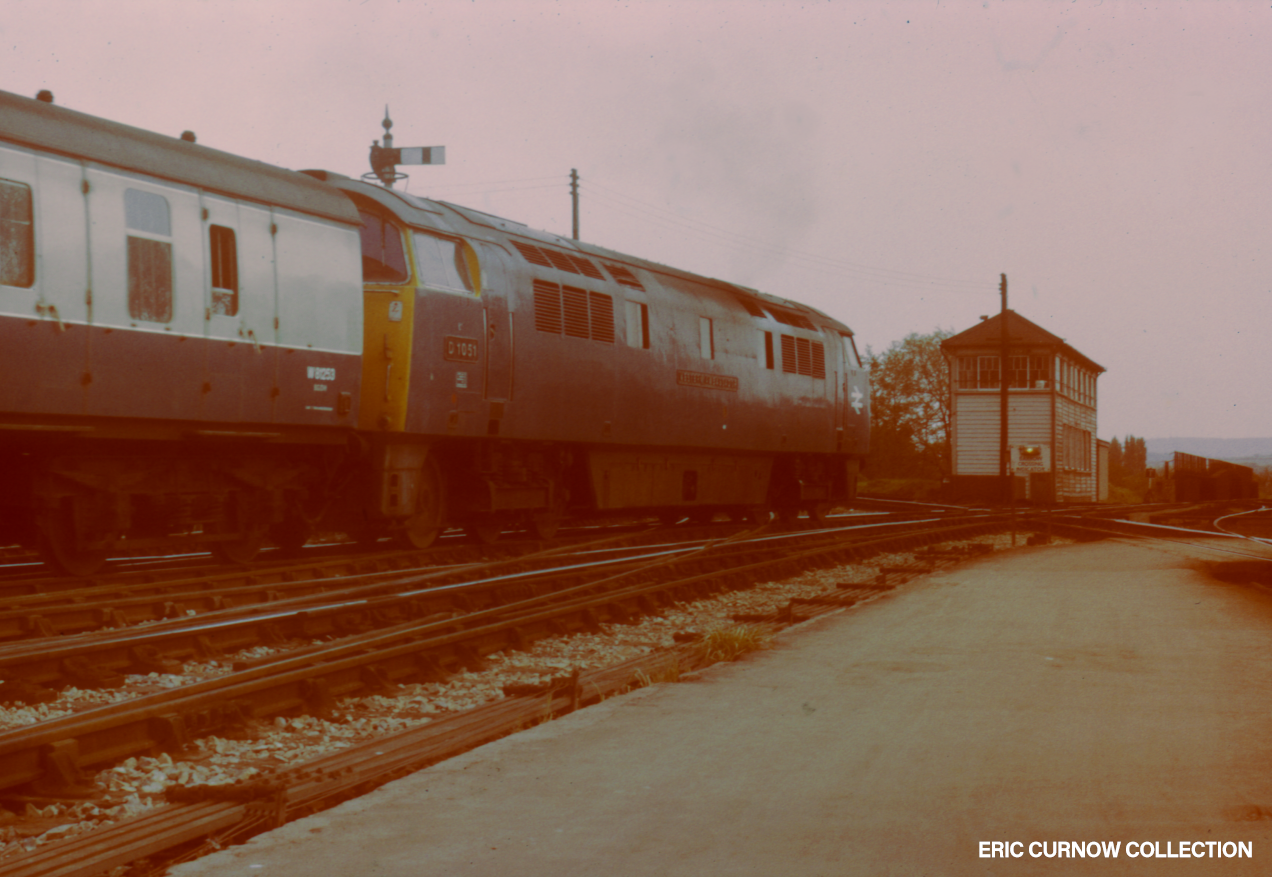
The ‘Barrow Crossing light’ is on as D1051 “WESTERN AMBASSADOR” crosses the lines curving left to Exeter Central, and is about to pass ‘Exeter West Signal Box’ on its way west in the mid 70s – the building now happily preserved at Crewe Heritage Centre. The locomotive is in surprisingly reasonable external condition at this late stage in its service life. 7####GF04-EXD-D1051-PAS_D
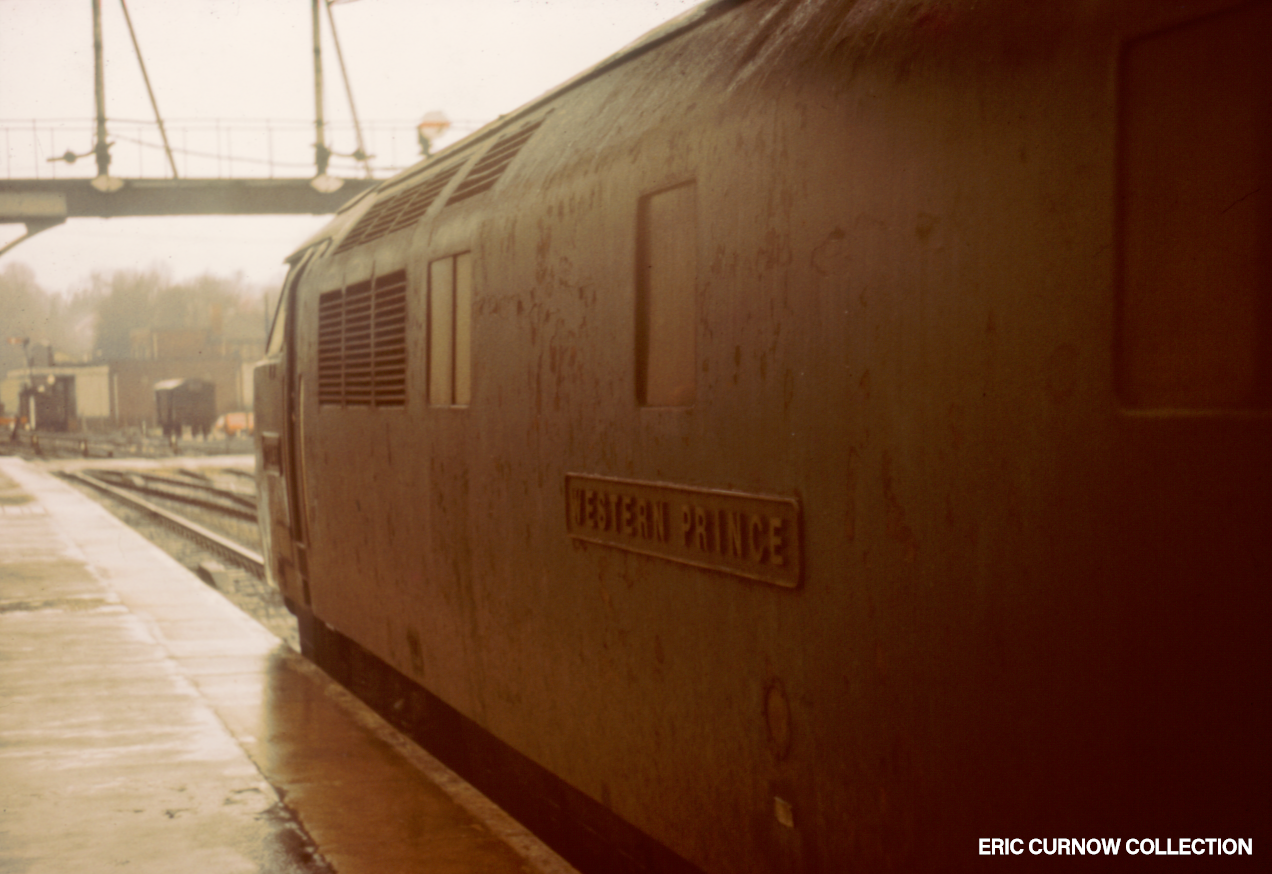
The dismal weather is not much improved by the appearance of the unkempt and pitted boyside of D1041 “WESTERN PRINCE”, although the throb and warmth of its engine and the exhaust gently blowing does partly recompense. Under the semaphores, D1048 waits to go eastward at Exeter St David’s, and Red Cow Crossing is clearly seen beyond. 7####GF03-EXD-D1041-PAS_U
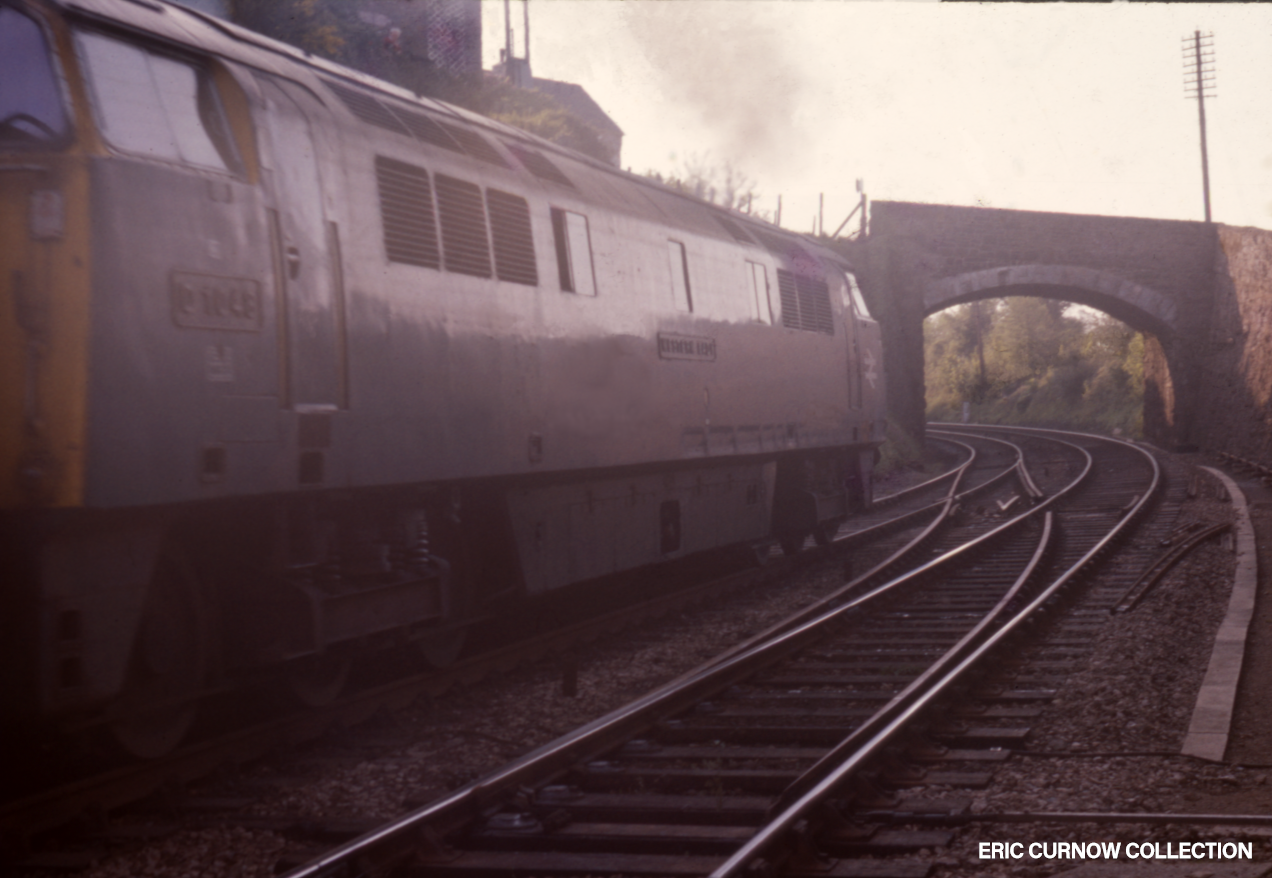
D1048 “WESTERN LADY”, straining its couplings and pumping out exhaust, leaves St German’s Station with a westbound service in late afternoon, probably late in its BR career. The loco’s bodyside shows damage from a ‘side swipe”, and the crossover beside it seems to be partly removed. St Germans is still a great place to while away a few hours between trains. 7####GF02-SGM-D1048-PAS_D
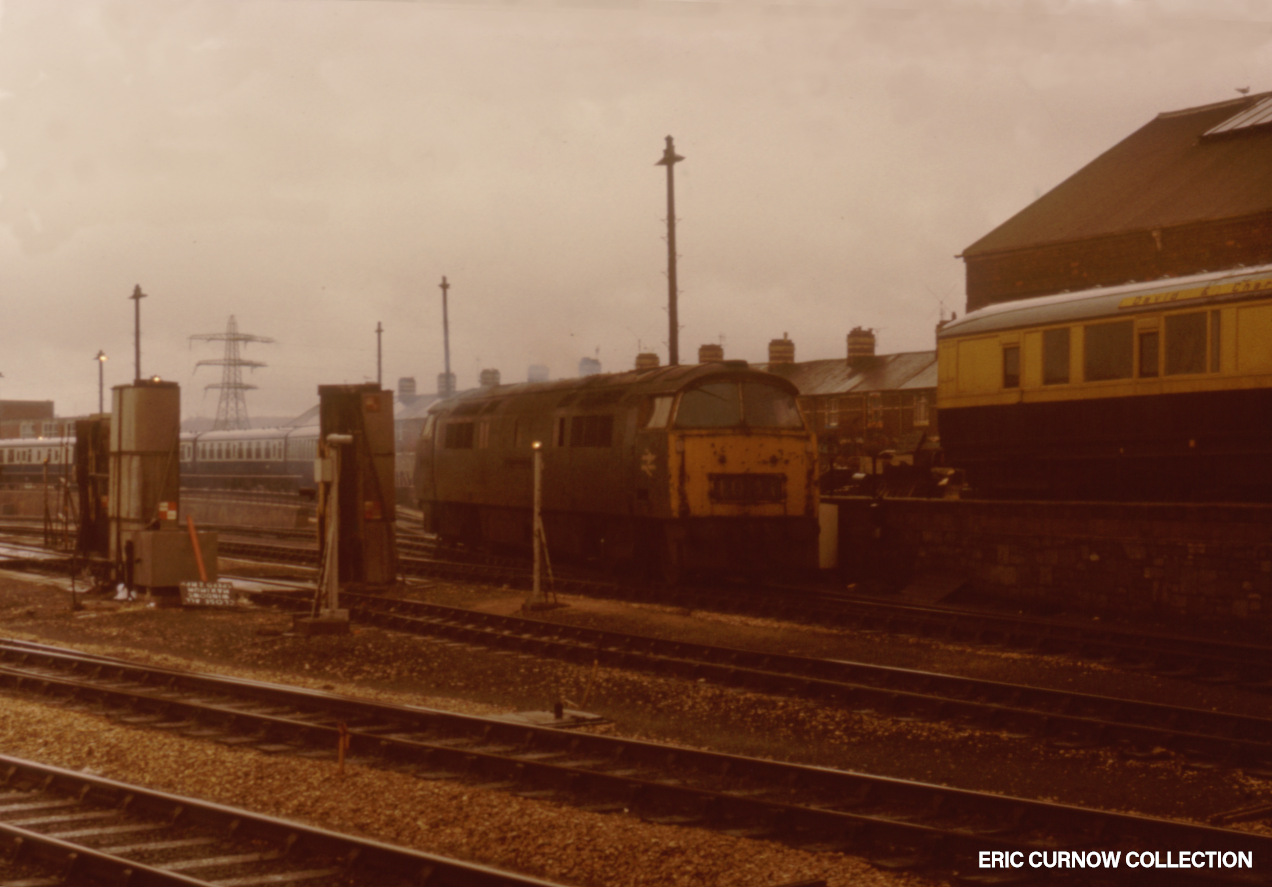
Before the line of railway workers dwellings, one of the few remaining Westerns, D1041 “WESTERN PRINCE” makes a foray westwards from Newton Abbot depot in very wet weather – the lights accentuating the grimness. A washing-plant is beside it on the right, and rakes of carriages behind in the yard. Like the locomotive, the days of the Works and depot here are numbered. 7####GF01-NTA-D1041-LIGHT
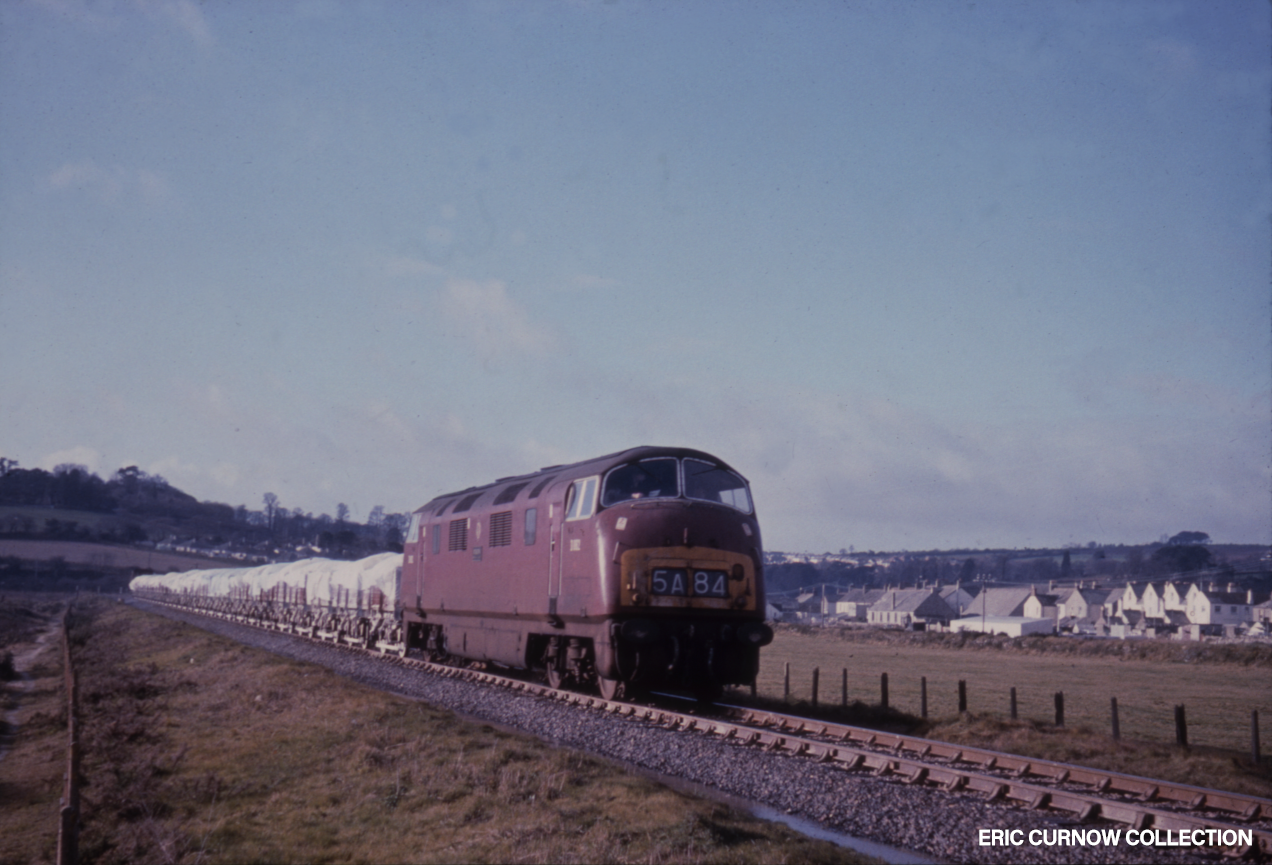
D862 “VIKING” pulls the 12.10 St Blazey to Fowey china clay at Par on 1st January 1968. I think this is my favourite ‘Warship’ photograph ever; the loco in maroon; the full train representing prosperity; the landscape uncluttered; capped off by it being a lovely Cornish day. I believe I remember witnessing such a sight myself, at the footcrossing further right. 1968###AH01-PAR–D862-C_CLY

On an inter-regional working, a class 47 loco with a train of Mk1 carriages looms from the shade of a cutting on a pleasant sunny evening. Undergrowth grows thickly on the sides of the banks, some still in flower, threatening to soon brush passing carriages. Alongside mellowed signalling conduit, the track shows recent ballasting and superficial oil discharge. 196####IE01-SER-47###-PAS_D
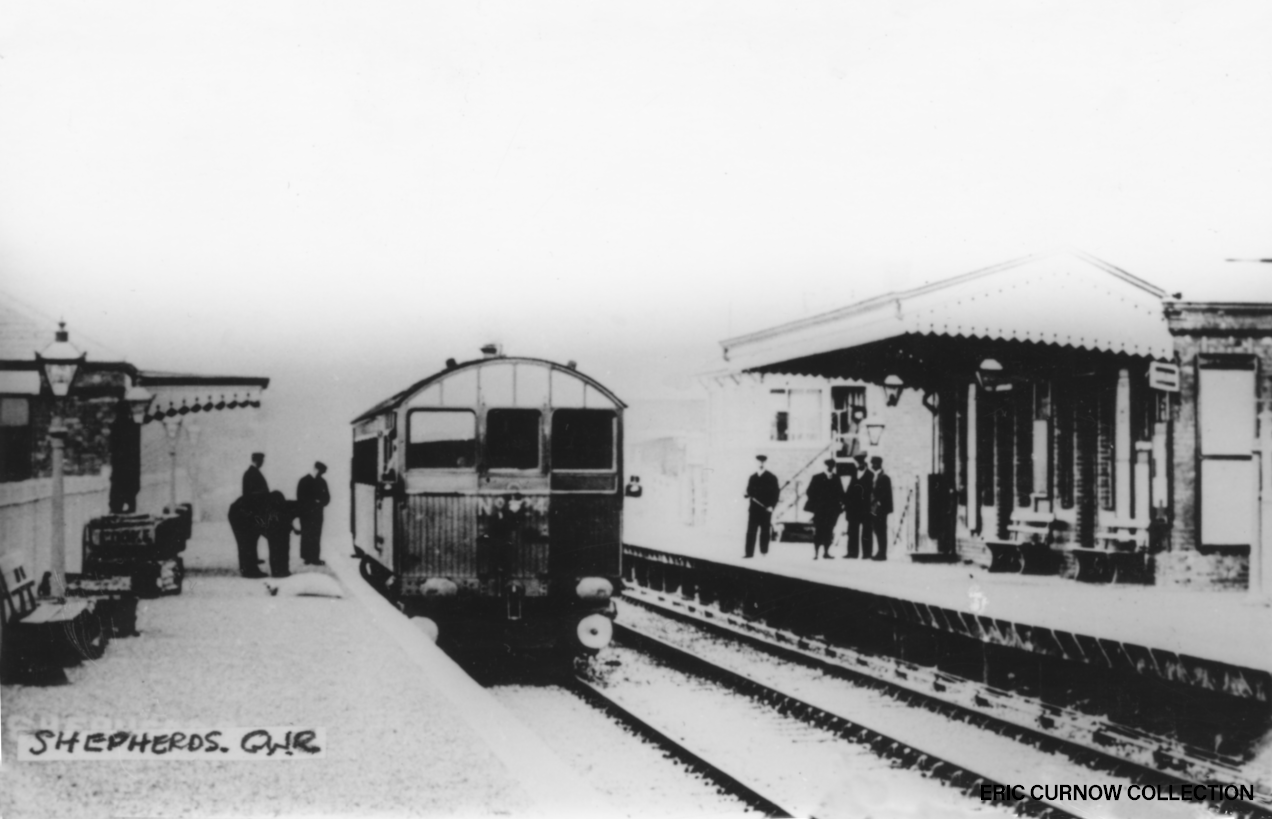
GWR rail motor no. 24 is pictured at Shepherds on a snowy day, surrounded by rail workers, some of whom who seem to be examining the side for some reason. It is bound for Chacewater, and snow on its lower front from an outbound trip gives the impression of four buffers. One staff member is paused and posed, shovel in hand, as the photograph is taken. 08####A01-SHD-D_TLR-PAS_I

In March 1979 a deserted late-night Kings Cross finds HS40000 ‘KESTREL’ before the buffers, presumably on a test run visit of some sort, as its headcode and A1 condition intimate. This beautiful machine follows the lines of the Class 47s, but is of much greater power, and it was a great shame a bulk order was not placed by British Rail. 7903#AA01-KGX-HS~00-PARKD

I can remember seeing this distinctive Stratford shunter at Liverpool Street, but what it was doing at Kings Cross – or any other shunter at this time, come to that – I’ve no idea. 08803 is carrying its former number (D4001), cycling lion transfer and black livery lined in red, the cockney sparrow emblem, and ‘Liverpool Street Pilot’ painted on its sides. 8####BL01-UNK-08833-PARKD
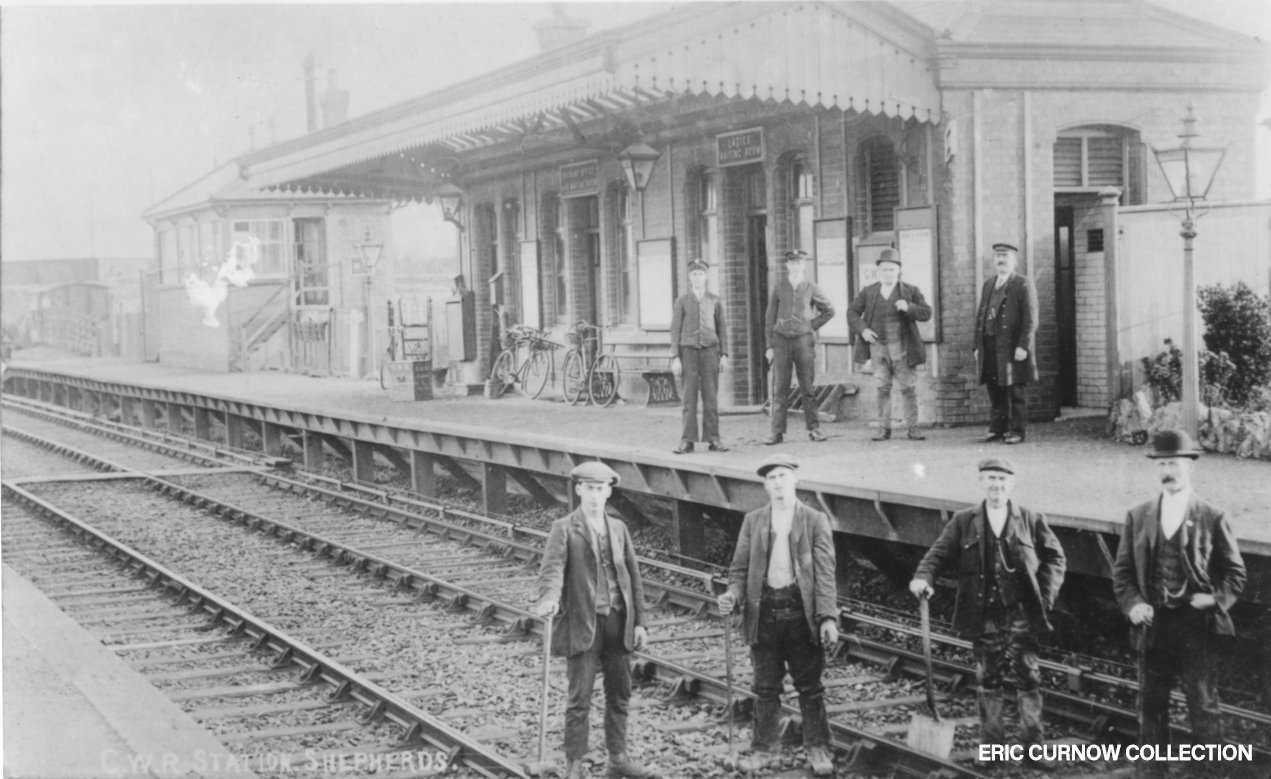
A permanent way gang pose with station staff at Shepherds on the Newquay to Chacewater Branch. The Station Building is typical GWR brick with wooden awning, a Gent’s toilet at this end, and seats and notice boards between doors and windows on its in facing side. The Signal Box can be glimpsed behind, along with rolling stock in a siding. 20###AB01-SHD-STATN-VI_SW

There were two stations between Truro and St Austell that closed long before I was aware of them: Probus & Ladock being the westerly of them. As shown, this was a timber construction on what looks like brick facades, in a cutting with large ‘Pagoda’ waiting rooms. I often looked for any remnant of this ‘Halt’, but was never sure of locating it. 32####A01-P&L-STATN-VI_NE

6938 “CORNDEAN HALL” is on shed at Penzance MPD in the early 1960s, as not only is there an 0-6-0 diesel shunter present, but also two D63XXs. A grounded van is sat at the entrance to the depot to provide more storage, and the site is crowded with locos. White ventilation chimneys plus two darker ones are still intact on the shed’s roofline. 6####IB01-LRK-s6938-PARKD

D600 “ACTIVE” leaves with a passenger service from Paddington in 1958, as ex-GWR 57XX 9702 arrives with empty coaching stock. The diesel is new, but has had some service use, and of course has yet to receive a yellow warning panel on its ends. Immediately behind the locomotive are some staff buildings, a ‘parachute’ water tower and a ballast heap. 5808##A01-PAD–D600-PAS_D

This really-interesting photo of the Bodmin & Wadebridge Railway circa 1888 shows what could be a junction – where the train has stopped and what, judging from their attire, could be the Directors inspecting the line at close hand. the rolling stock is stoutly built and a few examples are preserved by the National Railway Museum at York. 880629A01-UNK-COACH-PARKD
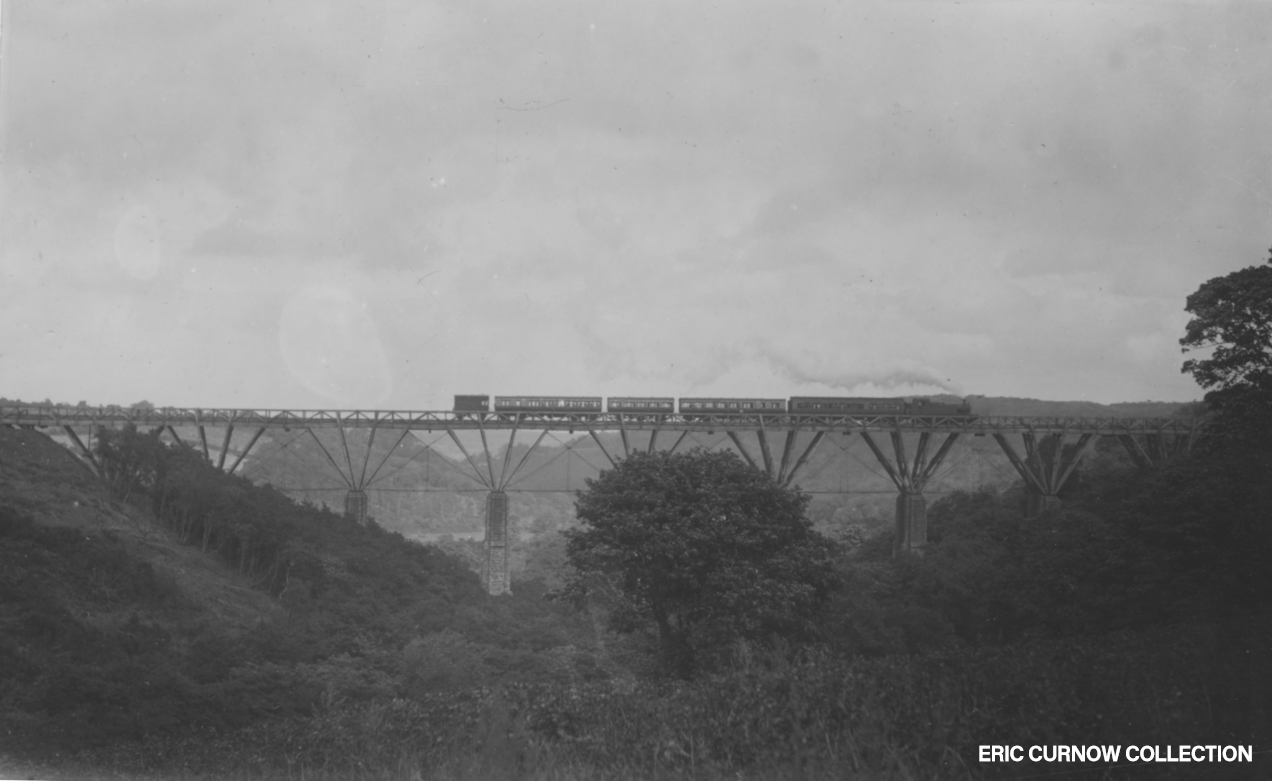
One of the many wooden Brunel viaducts in Cornwall, that sufficed well for the needs of the time, but were latterly replaced with masonary structures. The lightweight fan-vaulting worked well, but the beams inevitably took their toll from the Cornish weather. A 45XX tank hauls a clerestory roofed coach, three with lower rooflines and a horse box. #####AY01-UNK-VIADT-VISTA
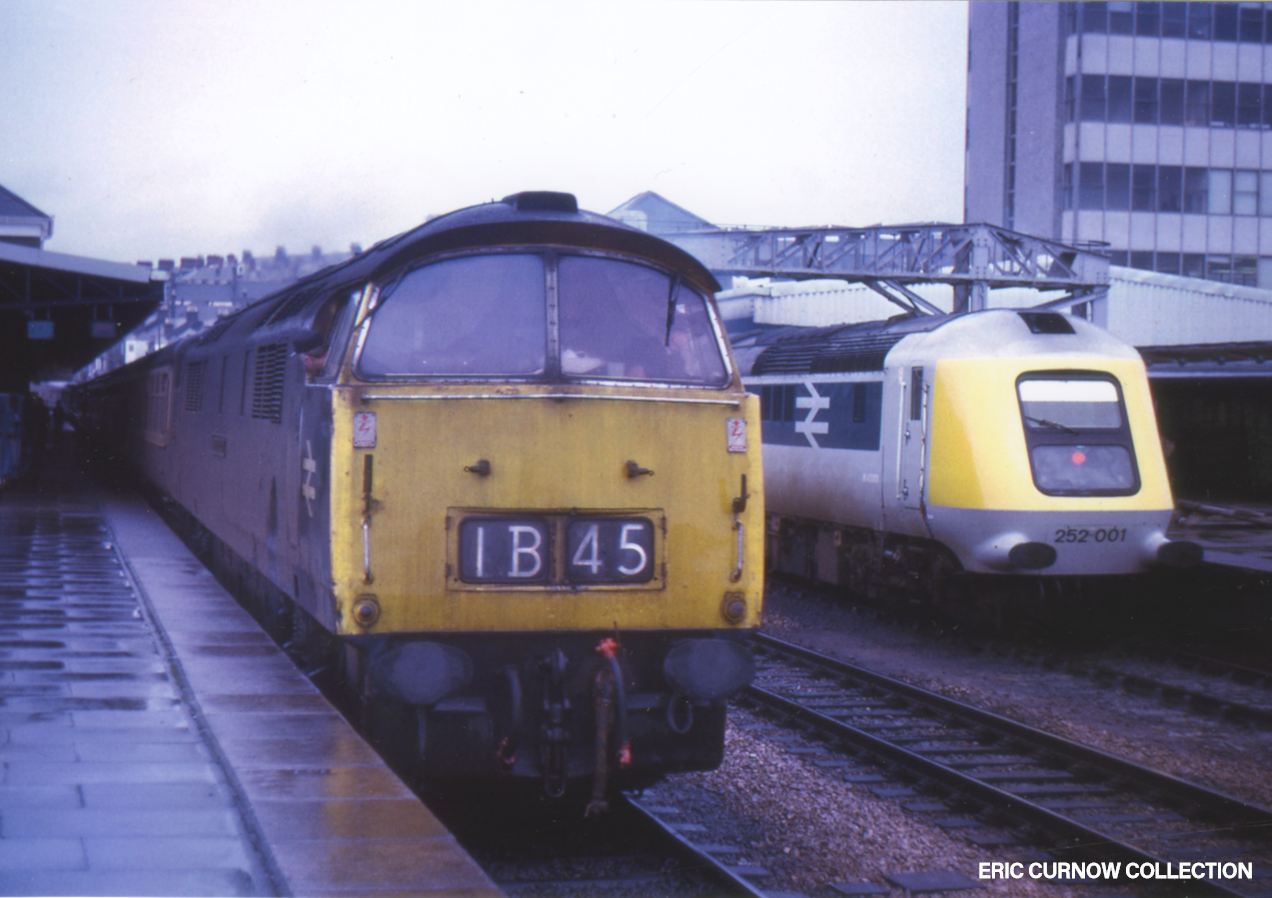
On a damp day in the early to mid 1970s, 252001 – the prototype High Speed Train – waits at Plymouth Station with red light suggesting its next movement is eastwards. Beside it is D1047 “WESTERN LORD” with Penzance-bound 1B45 ‘Cornish Riviera’ Express – the Second Man looking back along the train for the “right away” signal from the Guard. 7####GE01-PLY-LOCOS-PARKD

Such a prominent rail installation as this should be identifiable, but I just can’t get my mind around where it is. A Swindon-built ‘Warship’ diesel passes tracks away from station platforms with the 1B15 passenger to Penzace, and a 3-car DMU is behind on an incline: semaphores abound and a substantial small water tower is in the background. 6####IA01-UNK–D868-PASGR

A Swindon-built green and yellow-finished ‘Warship’ heads a train of chocolate and cream stock past a big station with sunstantial signal gantry – possibly Reading. The gantry supports are wooden, but the starter for the D8XX is very high tubular steel – suggesting an obstruction like a footbridge would obscure it from sight if it was just normal height. 6####HZ01-UNK–D8##-PASGR

The station with the peculiar signal box – Perranwell – that I am thankful my father pointed out to me on a Falmouth visit as a youngster. This view is towards Truro in 1936, and vans are parked under the ‘box that is necessary to access the goods shed, and signal the passing point on this once broad gauge width, but now standard gauge, single track line. 36###AE01-PRW-STATN-VI__E

As the running in board starkly proclaims, this is Grampound Road Station – the eastern end of the down platform with waiting shelter and staff hut, in 1936. Beyond the structure is the down siding, and tracks curving away towards St Austell. As can be seen from the scenery beyond, this is a very rural area, without much rail potential. 36###AD01-GPR-PLTFM-VI__E

Grampound Road looking east, taken from the road overbridge. I did see remnants of this station which were easier to find than Probus as there were nearby buildings as reference, and this print shows the station building on the left with Goods Shed and up siding behind, and platform shelter opposite. Photo: Locomotive & General. 07###AB01-GPR-STATN-VI__E

The route from Bodmin Town towards Padstow intersected with a line to Bodmin General at Boscarne Junction, where a ‘Halt’ consisted of a short platform on each deviation, connected by a half-minute walk between them. This is the GWR arm, with the route to Wadebridge to the left and Bodmin Town to the right, brhind the running in board. 56###AE01-BCX-STATN-VI__W

An ex-SR T9 Class 4-4-0 No 30709 waits at Padstow Station, Cornwall, in 1960. Superficially, the scene could easily be taken to be years earlier in Southern Railway days, and the running in board is definitely of that vintage. One variance though is the lorry beside the Station Building has ‘BRITISH RAILWAYS’ painted its tarpaulin cover. 60###AM01-PDW-30709-PAS_U
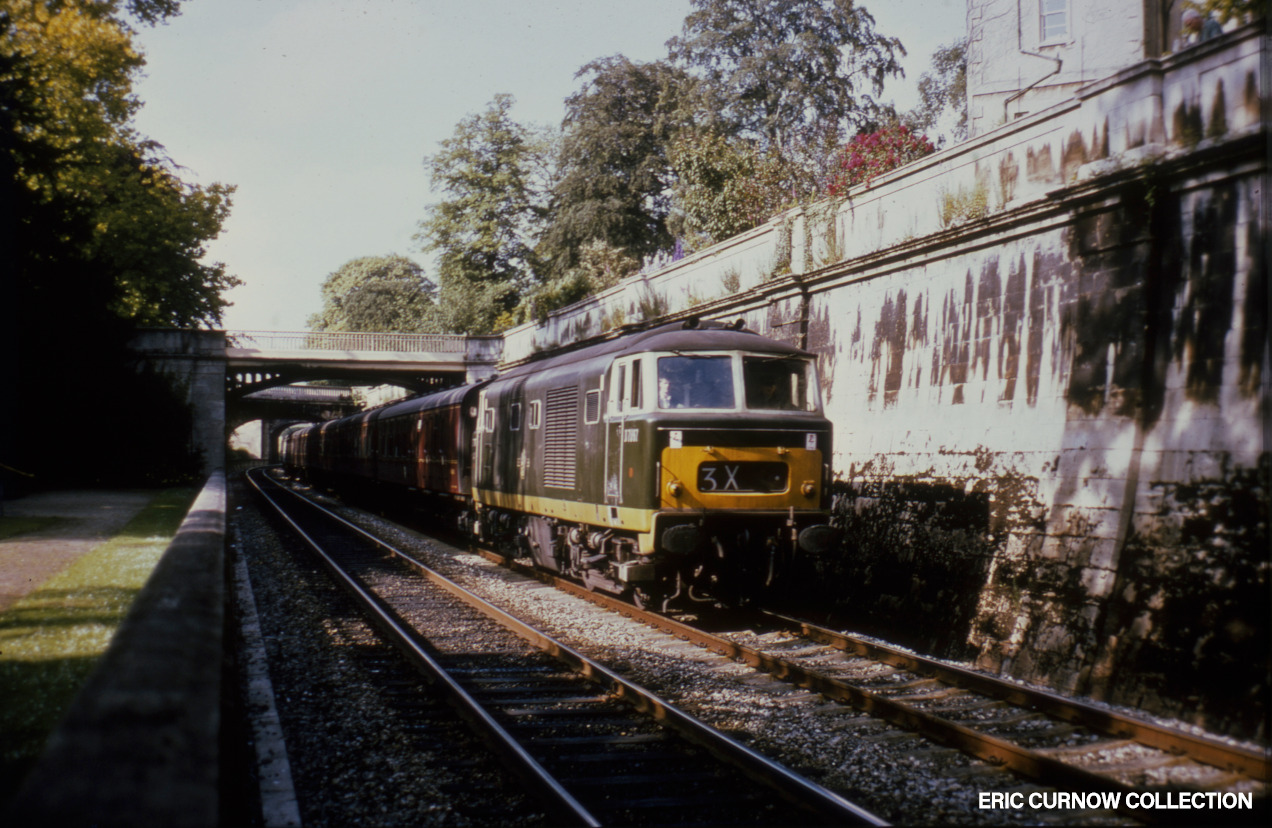
D7097 takes a maroon-liveried special westwards through Sydney Gardens, Bath, in July 1967. This must be the finest example of a railway breaching gardens as the graceful stone and ironwork demonstrate – permitting Brunel to bring the line into the city by this most suitable route. The curves and livery of the Hymek in the dappled sunlight helps too! 6707##A03-BTL-D7097-PAS_D

Track dust below the solebar and clay residue on the wheel rims cannot decry the splended finish of ‘Warship’ D860 “VICTORIOUS” outside Long Rock shed on 12th July 1966, though the buffer beam red seems brighter scarlet than usual. Inside are D600 and D6310, so the trio represent all hydraulic classes produced by the NBL in the West Country. 660712A02-LRK–D860-PAS_U
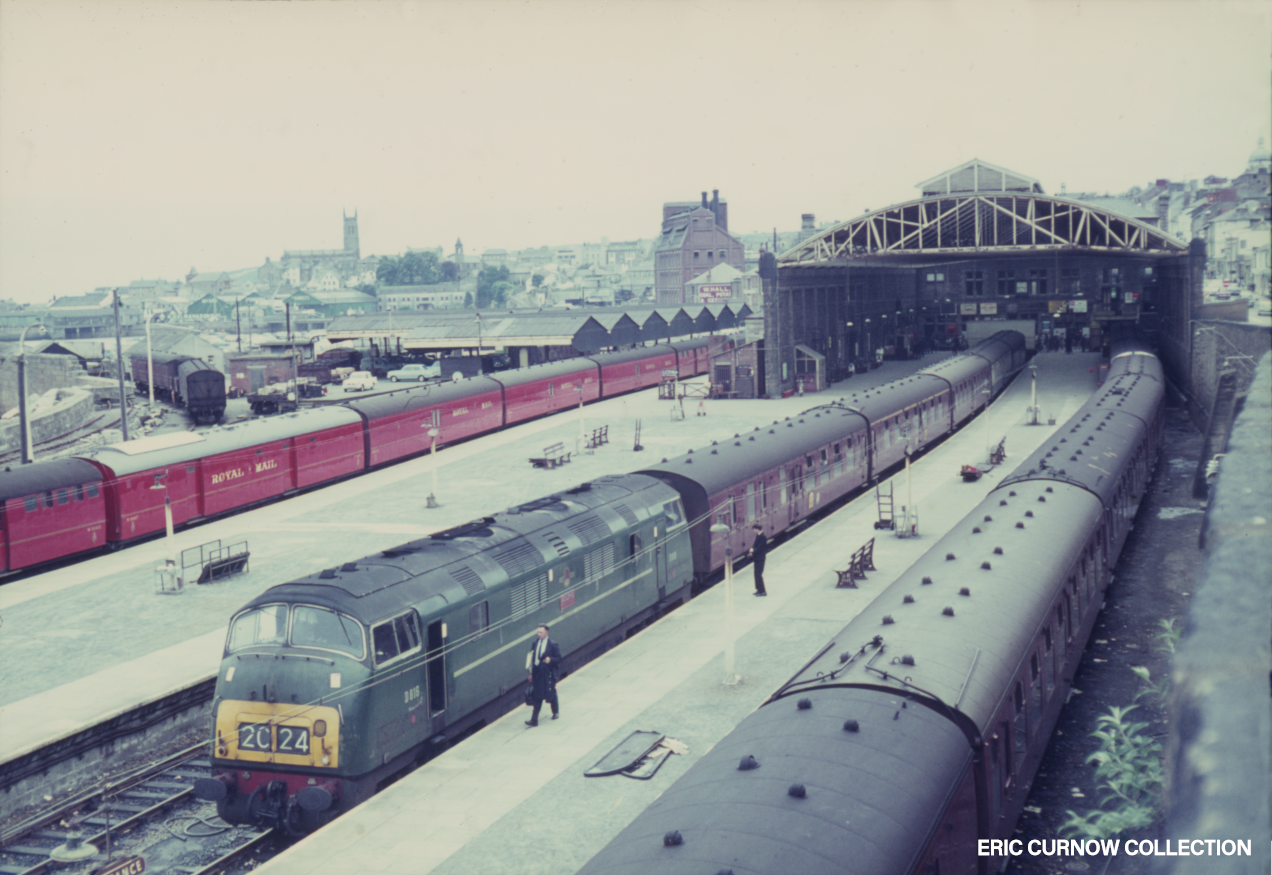
The driver strides towards the front cab of D816 “ECLIPSE”, heading the 4.20pm Penzance to Plymouth passenger on 12th July 1966. The coaches are stil all entirely maroon, apart from the rake of Royal Mail vehicles in pillar-box red. In the yard on the left, behind the two vans, are buildings that were demolished before my days of interest began. 660712A03-PNZ–D816-PAS_U

This rather unattractive postcard view of Camping Coaches at Marazion show delapidation, suggesting it was printed post-WW2 when resources of all sorts were scarce. A well-worn track runs toward the sea, a privacy sign hangs at an angle, and the boundary fence is broken – behind is the main line, station building chimneys and Long Rock village. #####AZ01-MZN-COACH-PARKD
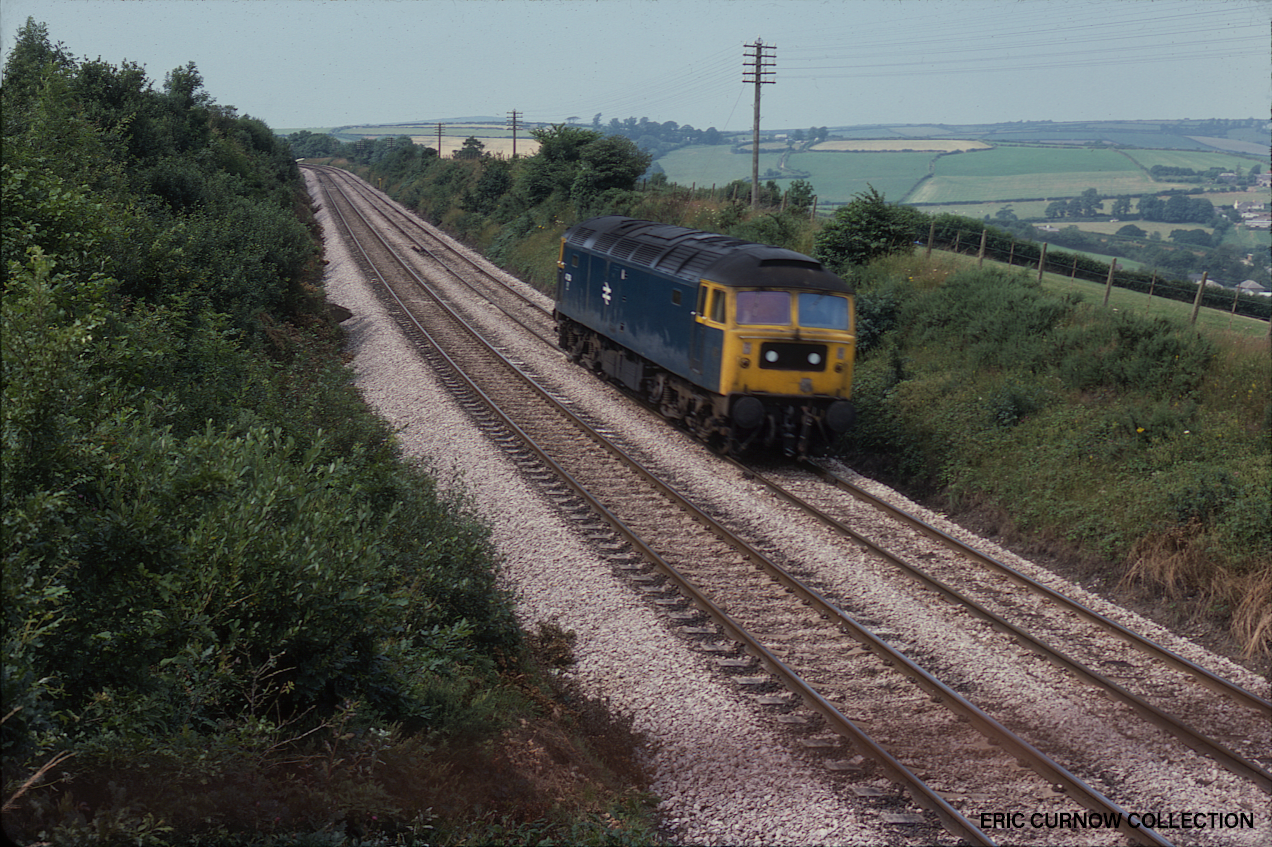
47134 runs light-engine eastwards close to Moorswater Viaduct in 1977. The track here illustrates well the vagaries of the Cornish main line, with the fairly straight stretch the locomotive is on following a tight bend to the left and another to its right onto the viaduct ahead of it. The 47 is in typical finish, with presentable sides but exhaust-caked roof. 770802A01-LSK-47134-LIG_U
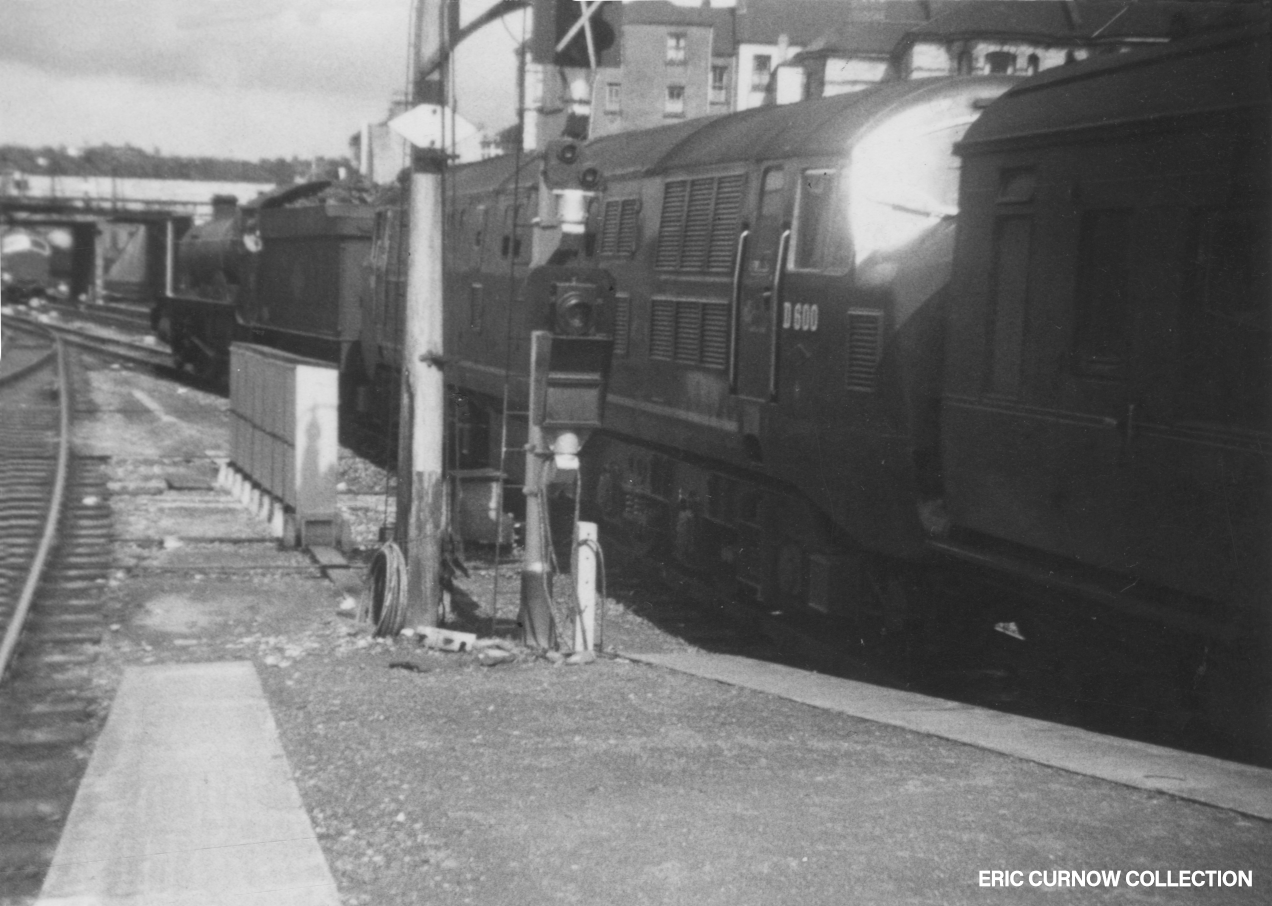
D600 “ACTIVE”, with original bodyside louvres, is piloted by a ‘Hall’ on an up passenger service from Plymouth North Road Station in the early 1960s, beside a rebuilt platform, old gantry and shunting/describer assembly, plus out-of-use ‘X’ covered new colour light signal. It will soon pass a D63XX diesel waiting under a semaphore gantry beyond. 6####AW01-PLY–D600-PAS_U
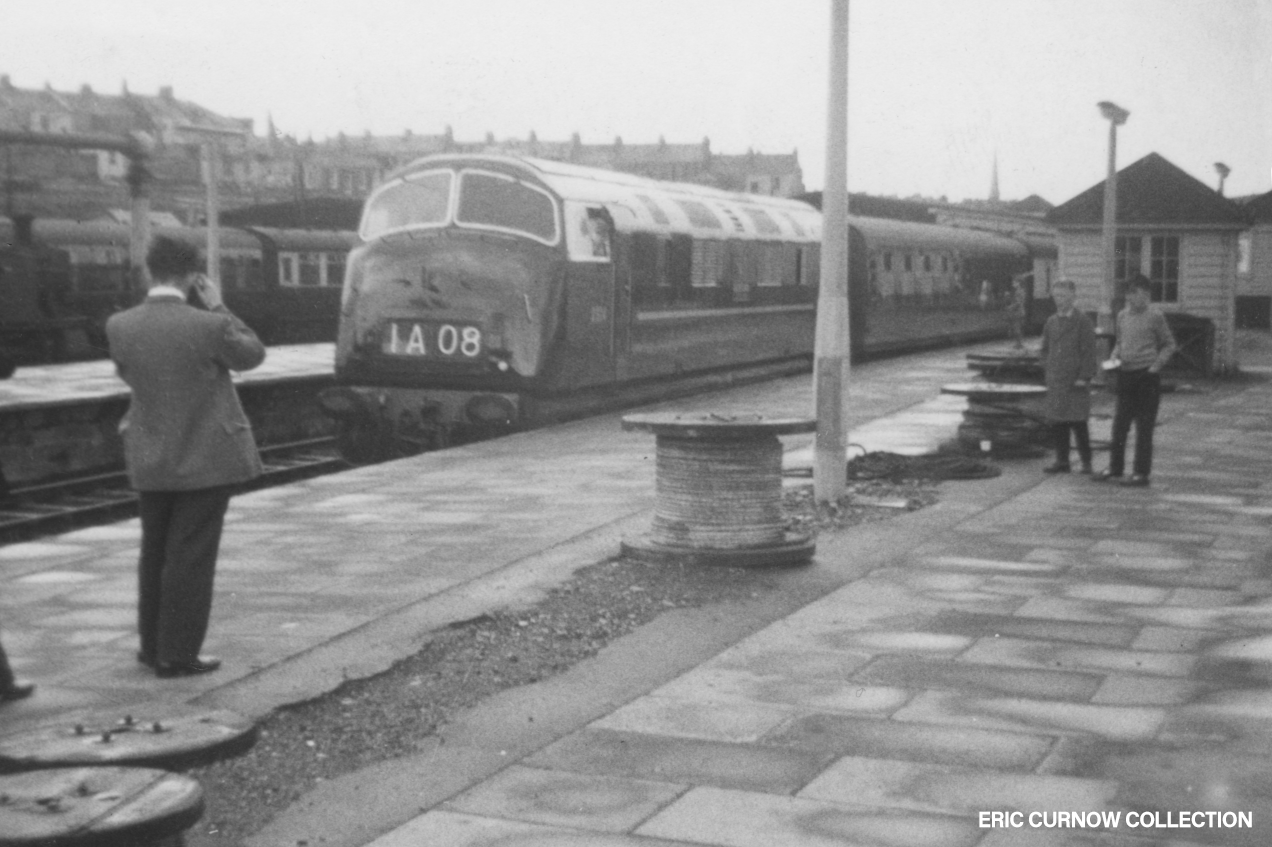
A new D806 “CAMBRIAN” stops at the end of Plymouth Station with a Paddington train of mixed-livery stock, creating sufficient interest for some train spotters to capture the sight on film. Cable spools, new lamp posts and a dug-over area indicate resignaling is going on, but a 45XX tank and water column show steam provision is still something to be considered. 6####BU01-PLY–D806-PAS_U

With safety valves lifting, British Standard 9F 92221, in poor external condition, attracts attention from platform passengers at Plymouth Station, heading a Class 3 freight – an up milk train. WR men prefered Swindon-built locos, but standard designs were tried out on some trains. Station rebuilding is going on, but the canopies and hut have not yet been replaced. 6####ID01-PLY-92221-TNK_M

4566 – the last ‘tank’ to be painted at Newton Abbot Works – slowly pulls away from a branch train from Helston at Gwinear Road Station, that it has just brought in, to run wrong-line down the track on the other side of the platform for the return journey. Neatly-raked platform gardens contrast strongly with the overgrown bank of the cutting side opposite. 6####IC01-GWI-s4566-PAS_I

25207 is parked between duties at the end of the line in Penzance Station yard, the weak sunshine casting indefinite shadows. It has lost a bodyside grille and its sides and apron look battered. Behind it is the concrete beam wall separating it from the Bus Station, and to the left the 1930s sea wall, with the remnants of the former one below it. 7####GF01-PNZ-25207-PARKD

Partially-truncated tracks into Marazion goods yard still exist along with rusting barrow crossing lamp post and loading gauge, as D1063 “WESTERN MONITOR” passes through with the 5.20pm Penzance to Manchester on 12th July 1966. The signal box still pulls off the signals at this time, but was to close about a couple of months later. 660712A01-MZN-D1063-PAS_U

Large tank engine 4206 smokes quietly as it awaits departure with a china clay train at Par on 11th July 1958.With its large firebox and side tanks it really “looks the business” for pulling such trains, of many covered wagons slowly creaking, clanking and groaning as they were hauled along jointed track in less than the finest of condition. 580711A01-PAR-s4206-PARKD
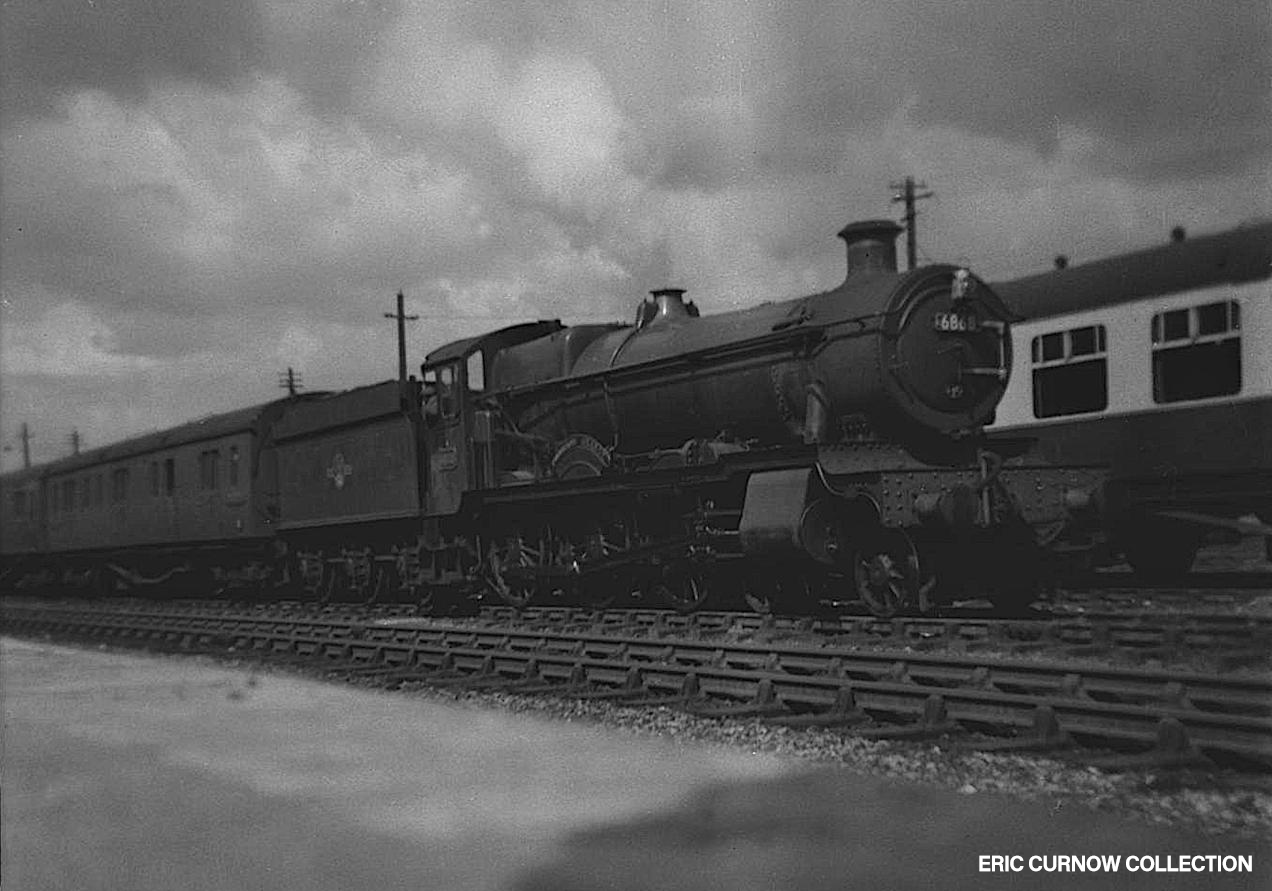
A frequent visitor to Penzance, 6868 “PENRHOS GRANGE” reverses an assembly of vans alongside a chocolate and cream carriage, in a scene reminiscent of Ponsandane Yard. The loco’s smokebox number is non-standard, and its overall cleanliness suggests that it normally had a more elevated than menial role. 5####CQ01-UNK-s6868-SHNTG
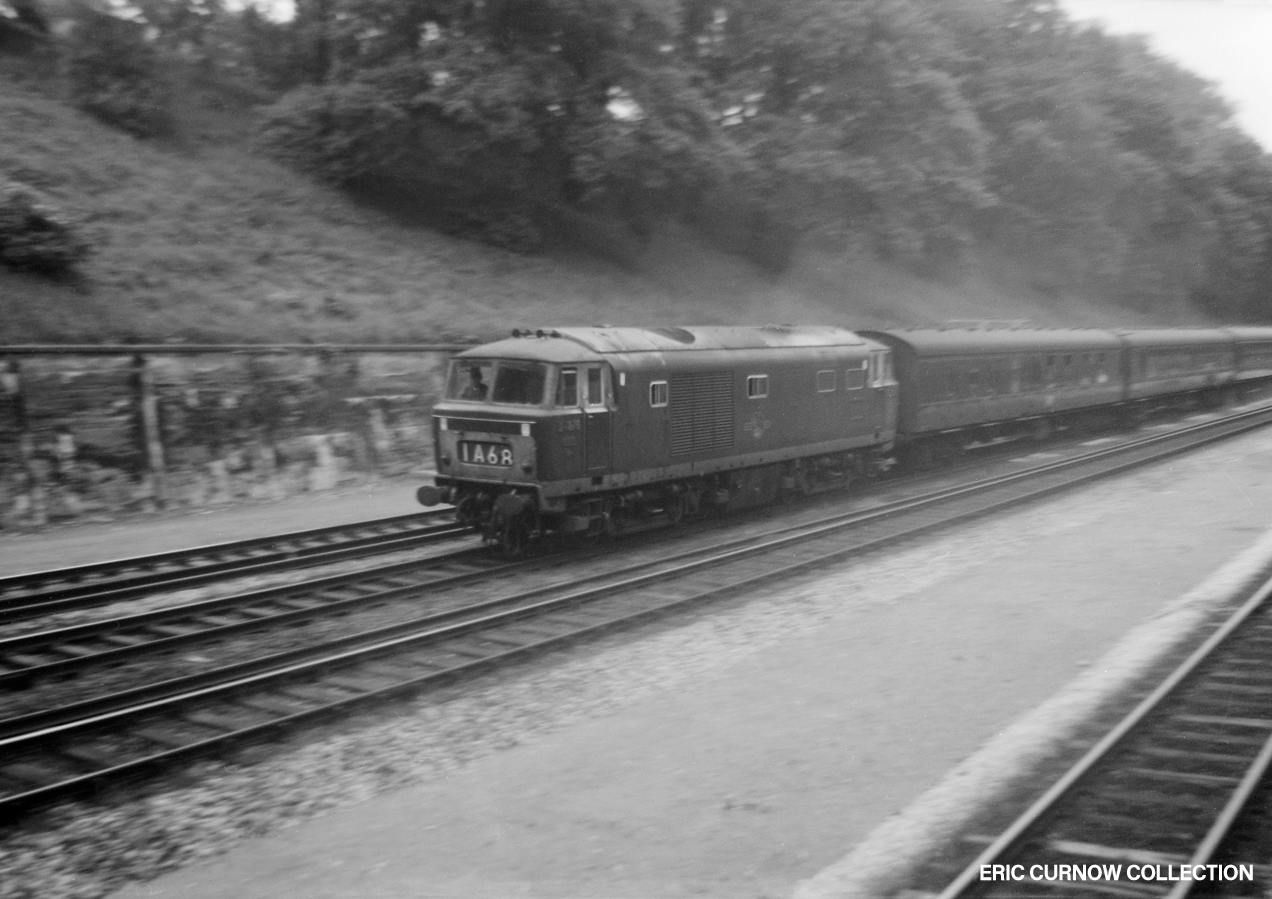
Speed and strength show in this negative of D7075, beautifully caught descending Sonning Cutting, east of Reading, in 1964. It is in two-tone green livery, with a rake of maroon coaches, and an incorrect headcode suggesting it is Paddington-bound. I am envious of how the photographer has made everything except the loco a blur – even the carriages. 64###AK01-RDG-D7075-PAS_D
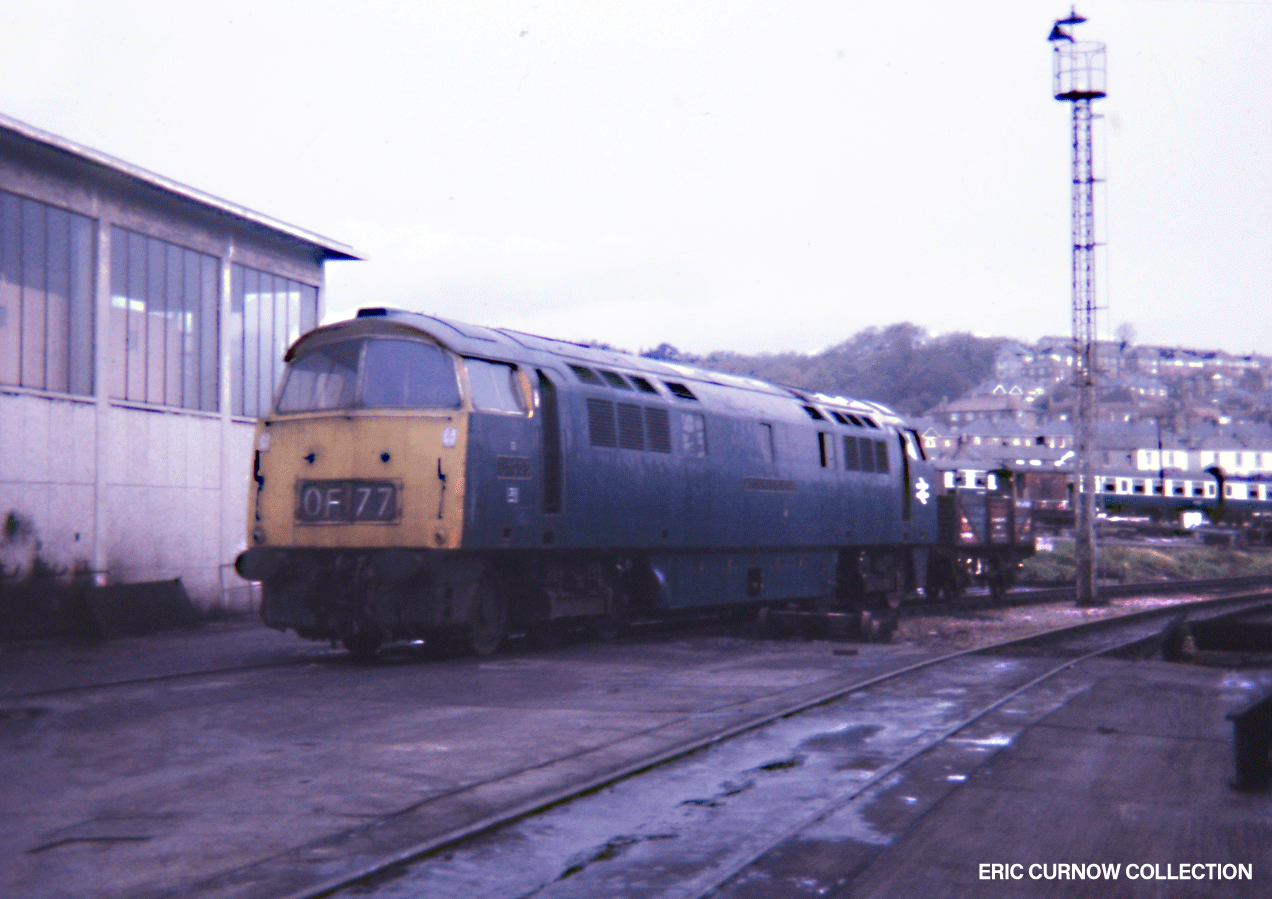
‘Western’ loco still bearing an operational headcode panel is parked beside the main building in a quiet moment on Laira shed, Plymouth, on a grey day. Behind are goods wagons and carriages, and in the foreground a concrete apron with draininge gully puddled with oil and water. A solitary lighting tower and hillside of homes overlooks the area. 7####FZ01-LAI-D10##-PARKD

